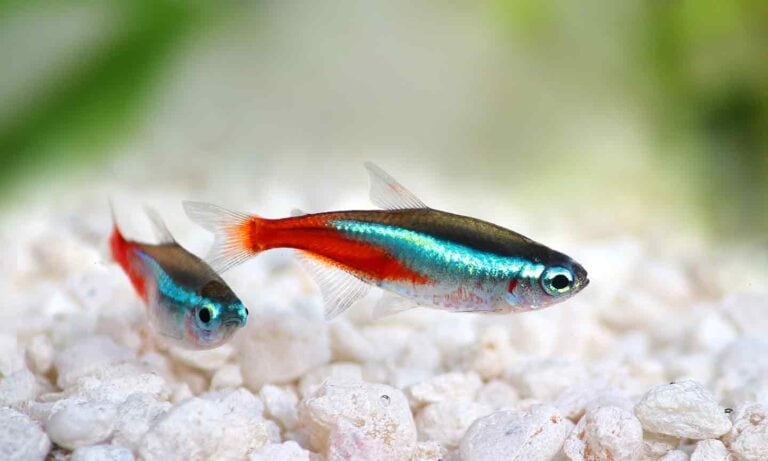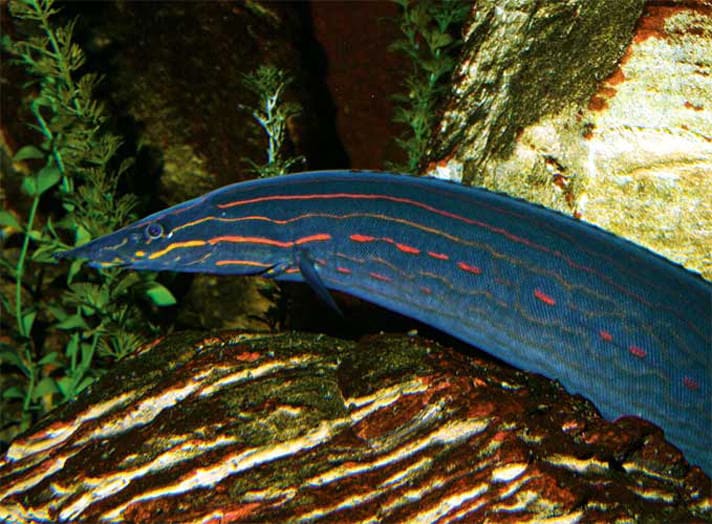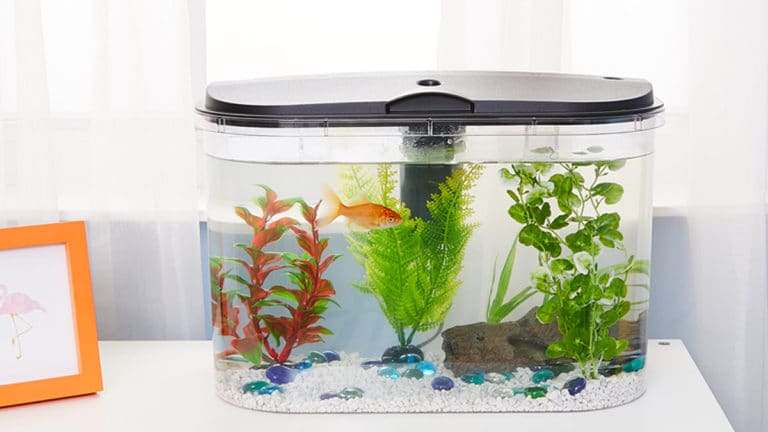Whether you’re cultivating a colorful reef tank or taking on the challenge of a coldwater marine aquarium, the right fish make all the difference. The ideal saltwater fish (or combination of them) for your tank will depend on numerous factors, including your tank size and conditions.
In this guide, we explore 30 of the best saltwater aquarium fish species.
The 30 Best Saltwater Fish for Aquariums
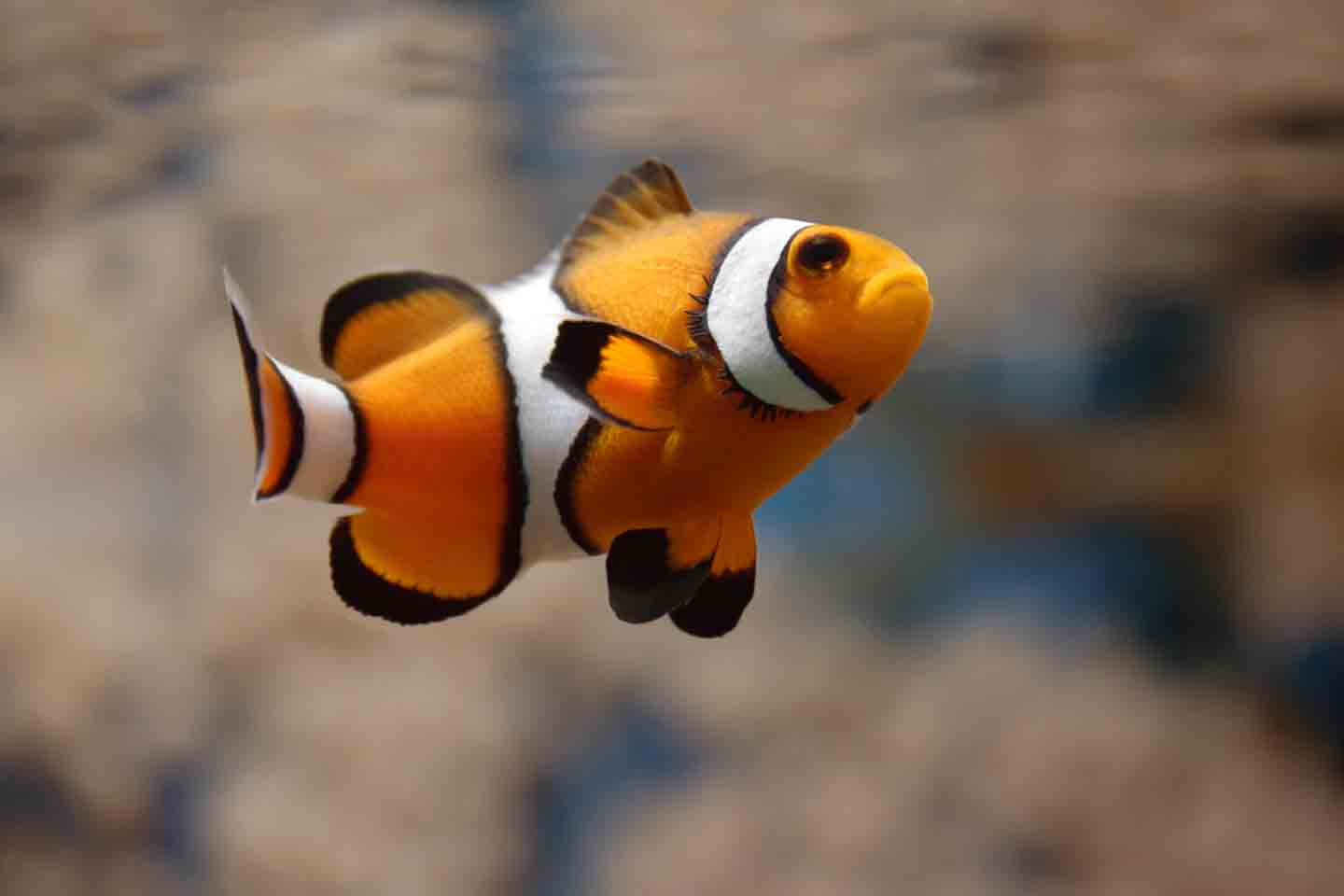
1Ocellaris Clownfish
- Scientific name: Amphiprion ocellaris
- Adult size: 3-4 inches
- Life expectancy: 8-12 years
- Best tank mates: Small and peaceful marine species
One of the most popular species for saltwater fish tanks, ocellaris clownfish are also very beginner-friendly. They have a stocky, oval-shaped body that ranges in color from orange to reddish-brown. This species has three vertical white stripes outlined in thin black lines. They can be kept in fish-only tanks but will be happiest in a tank stocked with anemones.
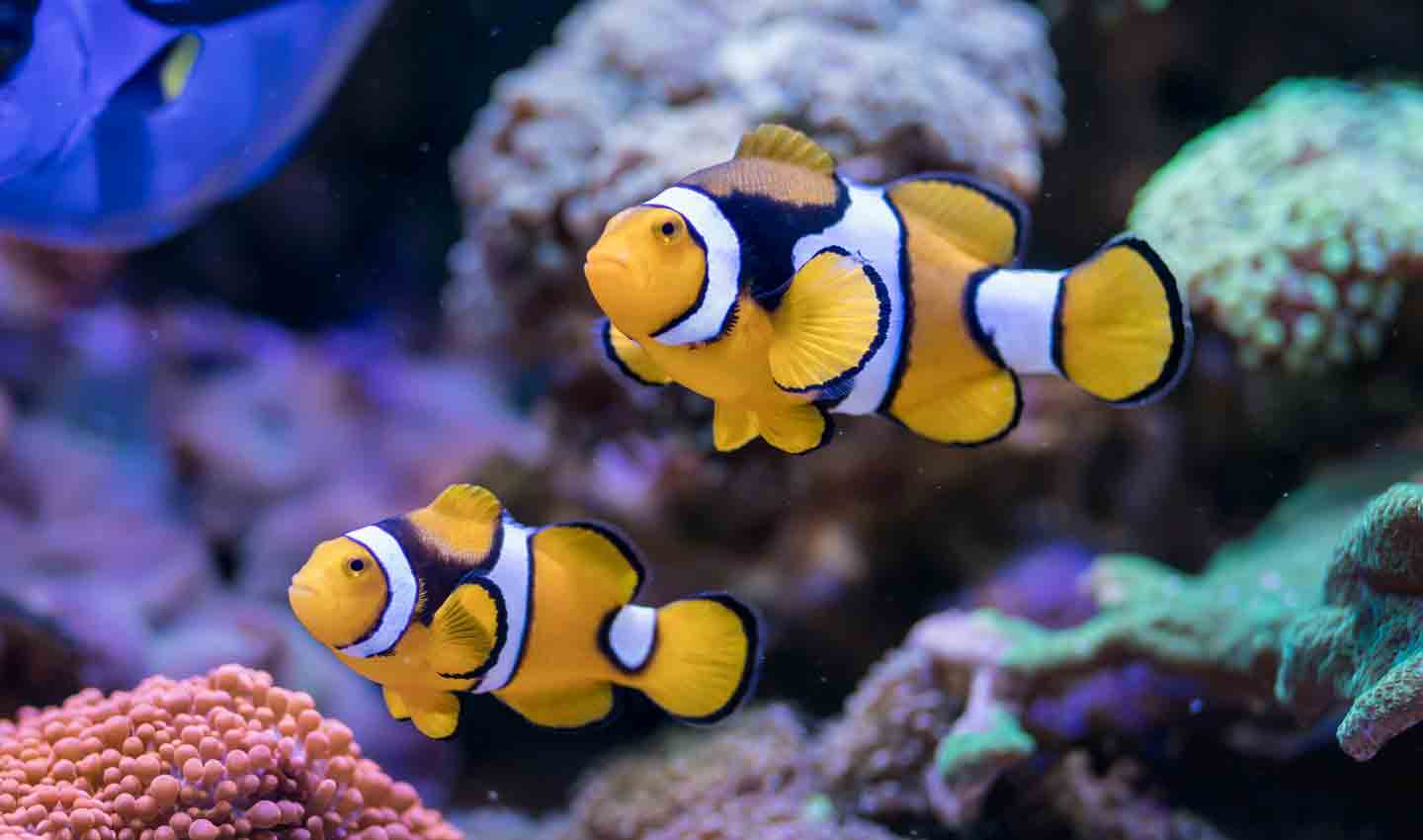
2True Percula Clownfish
- Scientific name: Amphiprion percula
- Adult size: 2-4 inches
- Life expectancy: 6-10 years
- Best tank mates: Small and peaceful marine species
Nearly identical to the ocellaris clownfish, this species can be distinguished by the thickness of the black lining each white stripe. Their care requirements are similar to ocellaris clownfish. This species is suitable for nano tanks with proper attention to water quality.

3Spotted Watchman Goby
- Scientific name: Cryptocentrus cinctus
- Adult size: 4 inches
- Life expectancy: 3-5+ years
- Best tank mates: Pistol shrimp, peaceful marine species
Also known as the yellow prawn-goby or yellow watchman goby, this species is native to the Indo-Pacific. They’re best known for forming symbiotic relationships with marine shrimp and are often kept with pistol shrimp in home aquariums. Spotted watchman gobies range in color from bright yellow to dull gray with blue or light-colored spots.
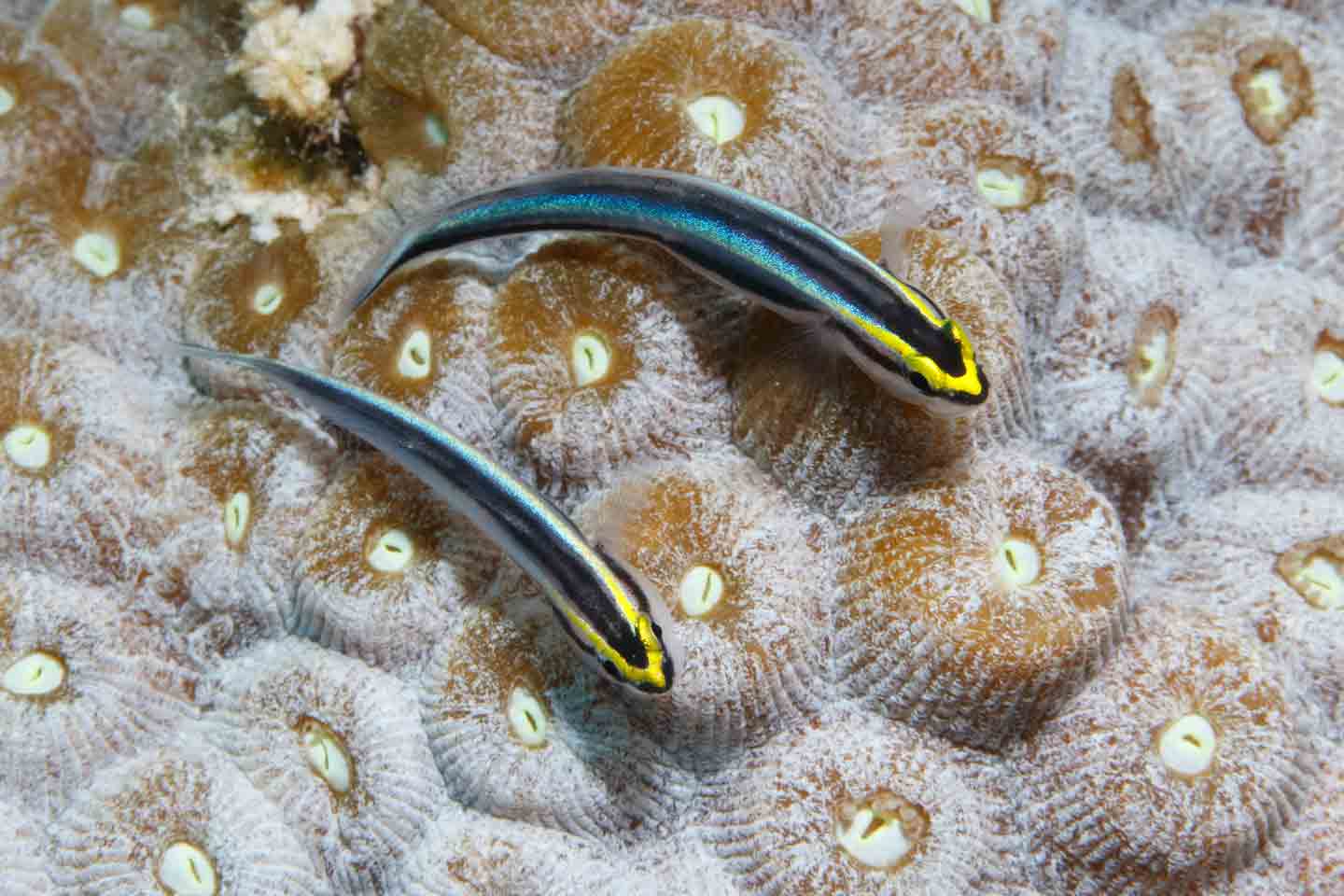
4Sharknose Goby
- Scientific name: Elacatinus evelynae
- Adult size: 1.5 inches
- Life expectancy: 2 years
- Best tank mates: Peaceful marine species
The sharknose goby is also known as the Caribbean cleaner goby due to their habit of eating parasites off larger fish. They’re small with a torpedo-shaped body covered in thick black horizontal stripes. Most sharknose gobies have lighter coloring on the underside with a blue stripe along the body that transitions to yellow near the head.
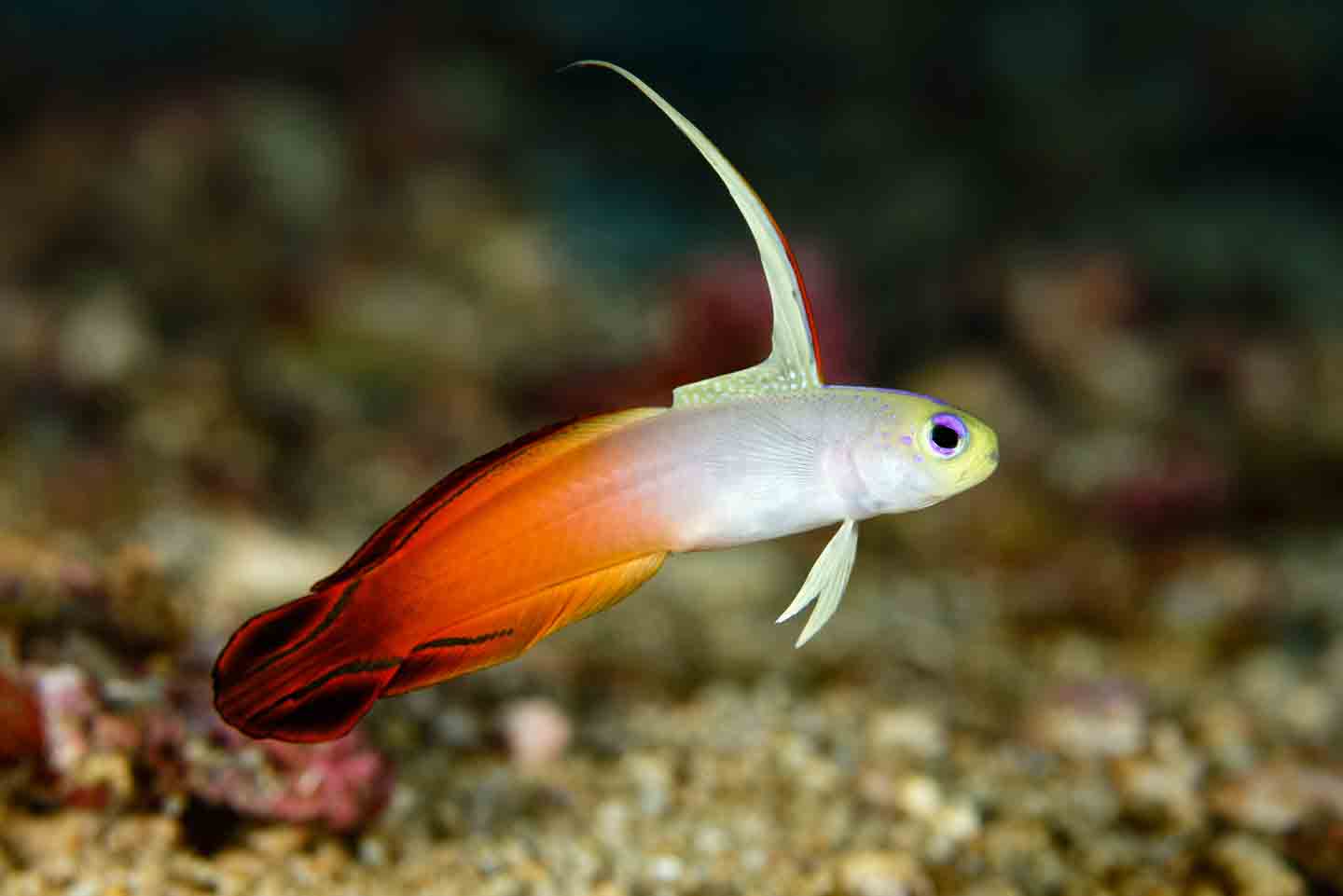
5Fire Goby
- Scientific name: Nemateleotris magnifica
- Adult size: 3 inches
- Life expectancy: 3 years
- Best tank mates: Peaceful marine species
Also known as firefish or fire dartfish, fire gobies have a long, pointed dorsal fin, which they flick back and forth to signal other fish. The fire goby has a white body with an orange-red tail and bright yellow head. They generally feed on small invertebrates and are reef-safe and compatible with small and slow-moving non-goby tank mates.

6Blue Bird Wrasse
- Scientific name: Gomphosus caeruleus
- Adult size: 12 inches
- Life expectancy: 5-7 years
- Best tank mates: Active and semi-aggressive species
A great fit for fish-only saltwater aquariums, the blue bird wrasse is unique in appearance. Males are blue and green in color, and females have black stripes by the eyes and yellow tail fins. These fish are named for their beaklike snouts. The blue bird wrasse is semi-aggressive and may eat smaller fish, so they’re best suited to large tanks. They can be aggressive with other long-body fish and may outcompete slow swimmers for food.
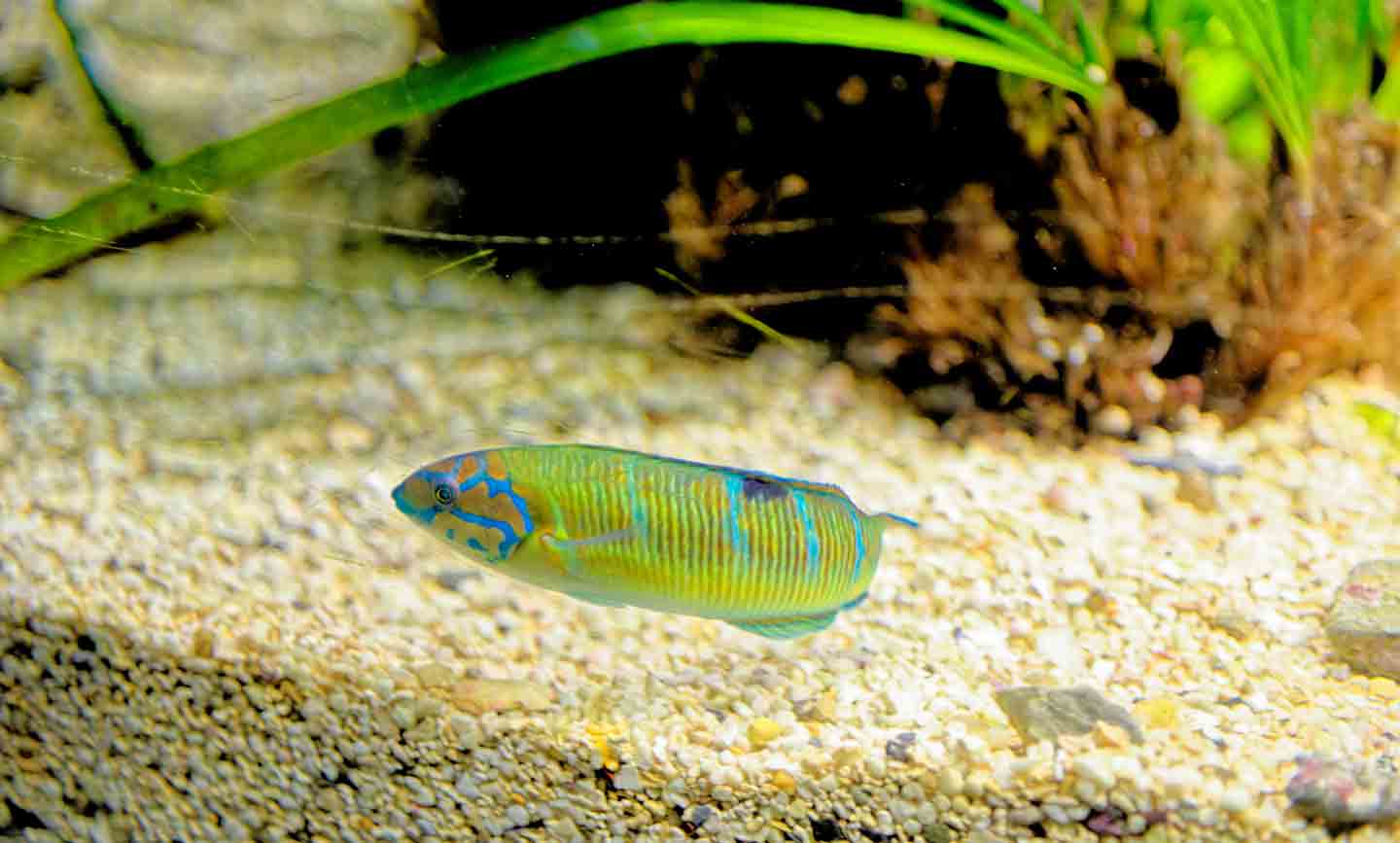
7Rainbow Wrasse
- Scientific name: Coris julis
- Adult size: 6-10 inches
- Life expectancy: 2-4 years
- Best tank mates: Aggressive or semi-aggressive, active marine species
Found throughout the Mediterranean Sea and northeastern Atlantic, the rainbow wrasse exhibits a wide range of colors in shades of green, blue, yellow and brown. Their color changes as they mature from the juvenile stage. Like other wrasses, this species may be territorial toward other wrasses and may be aggressive toward smaller, slower fish.
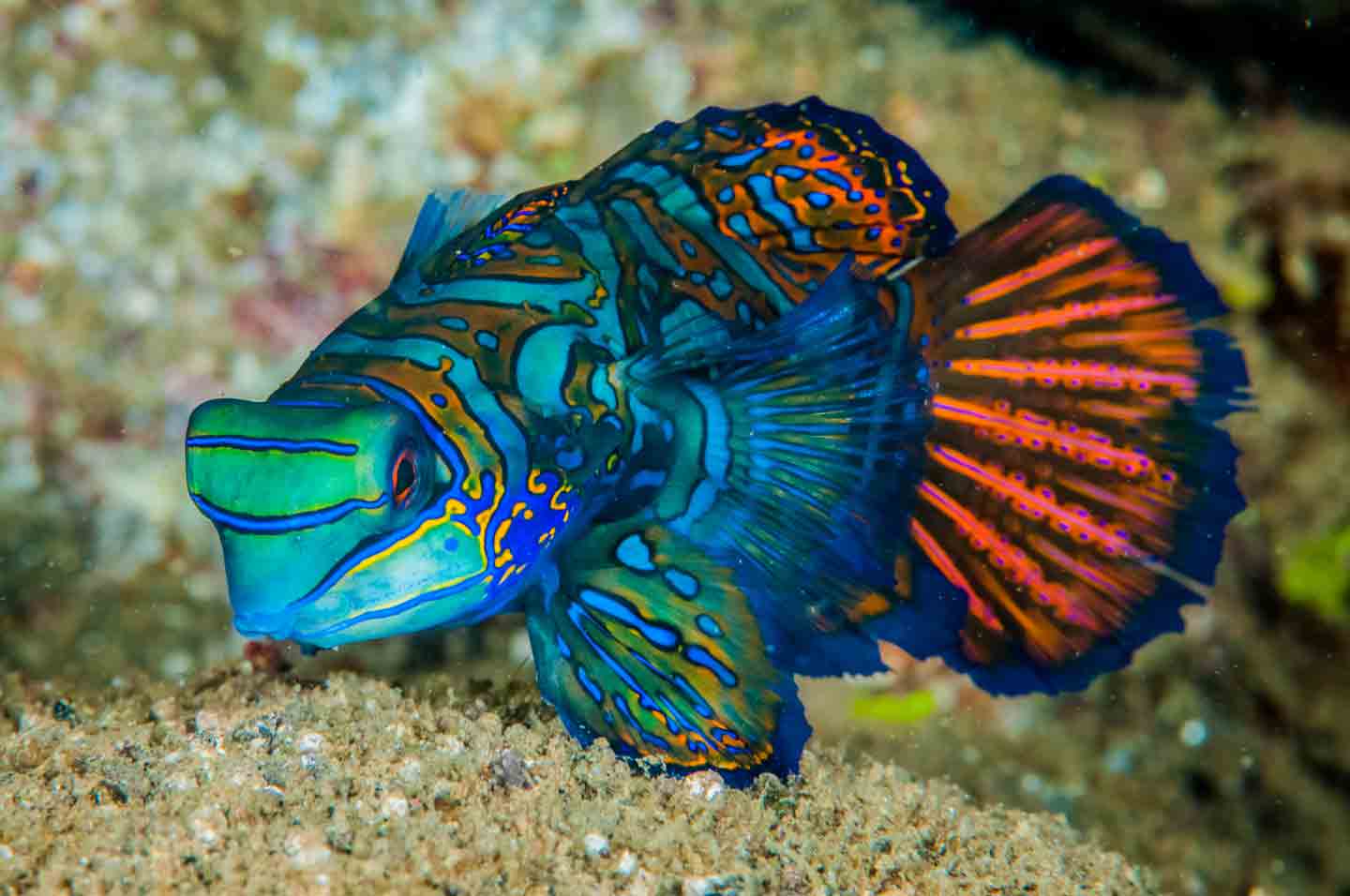
8Mandarin Dragonet
- Scientific name: Synchiropus splendidus
- Adult size: 3 inches
- Life expectancy: 2-4 years
- Best tank mates: Small to medium, peaceful reef fish
Also known as the mandarinfish, this species is one of only a handful of vertebrates that exhibit true blue pigmentation. These little fish have distinctively large pelvic fins they sometimes use to “walk” across the seafloor. Due to their specific feeding habits, mandarinfish are best suited to experienced reef hobbyists.
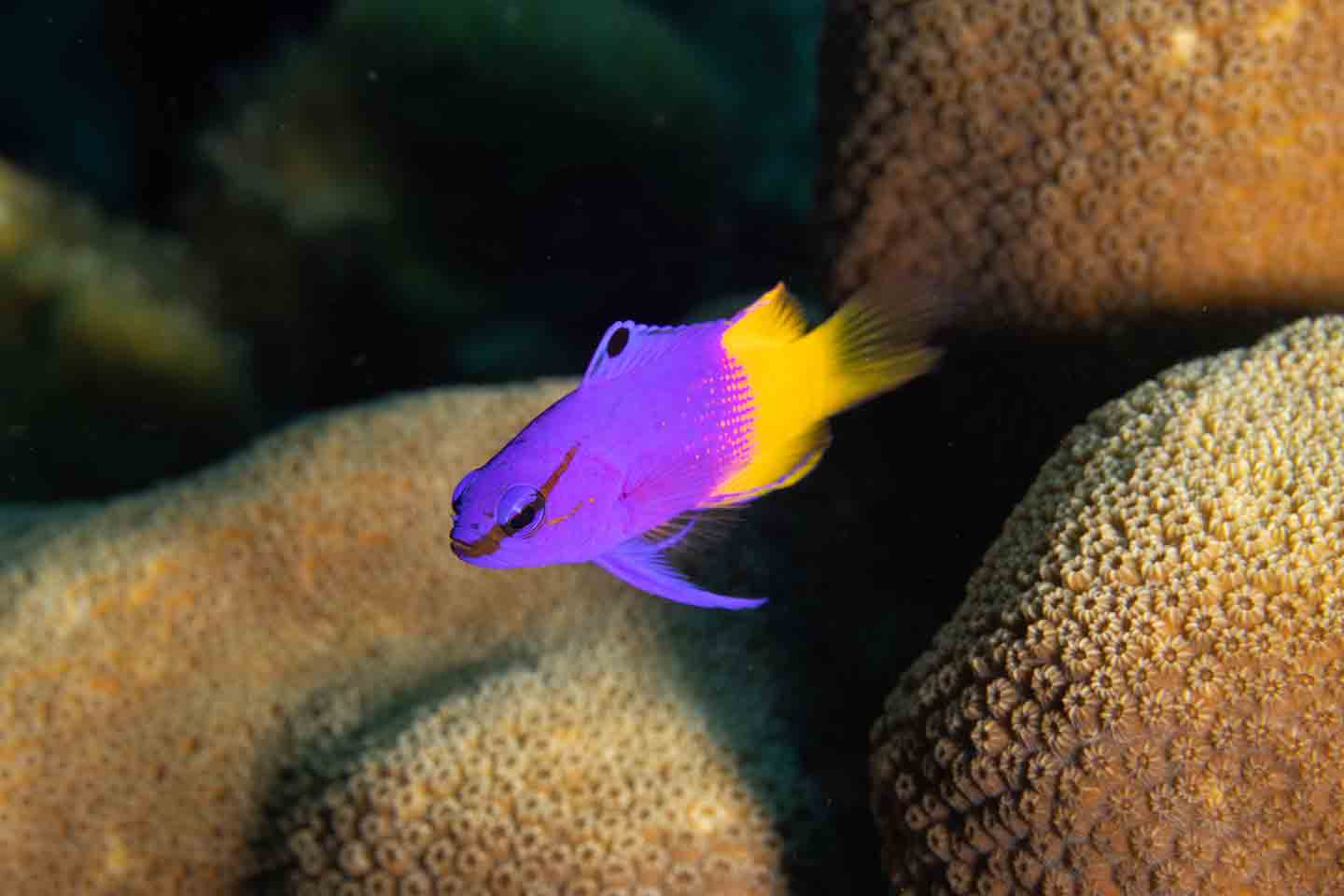
9Royal Gramma
- Scientific name: Gramma loreto
- Adult size: 3 inches
- Life expectancy: 5-10 years
- Best tank mates: Peaceful community reef species
Also known as the fairy basslet, the royal gramma is a popular, reef-safe species native to the Caribbean and western Atlantic Ocean. These fish are easily identified by their bright violet coloring, which fades to golden yellow at the back. Royal gramma are considered planktivores and cleaner fish. They feed primarily on zooplankton and invertebrates, but will also eat parasites off other fish.
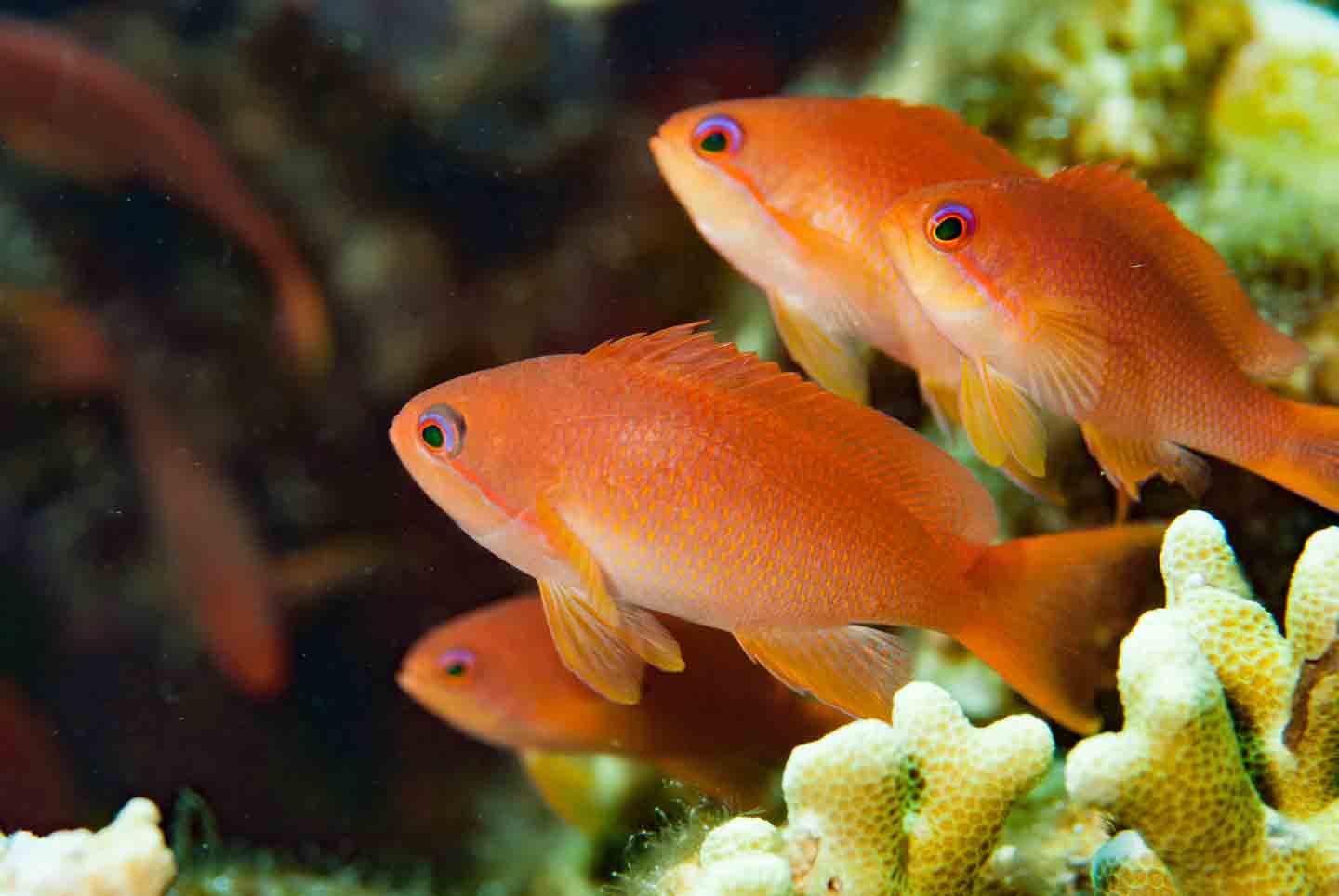
10Lyretail Anthias
- Scientific name: Pseudanthias squamipinnis
- Adult size: 5 inches
- Life expectancy: 5-7 years
- Best tank mates: Peaceful community reef species
Widely distributed throughout the Indian and Pacific Oceans down to Australia, lyretail anthias are some of the most brightly colored reef fish you’ll come across. Both sexes are vibrantly colored, but males tend to exhibit red or purple tones while females are often yellow-orange. Despite being fairly small, lyretail anthias can be aggressive and territorial if stressed (i.e., being underfed or kept in a tank that’s too small). They’re best kept in large reef tanks.
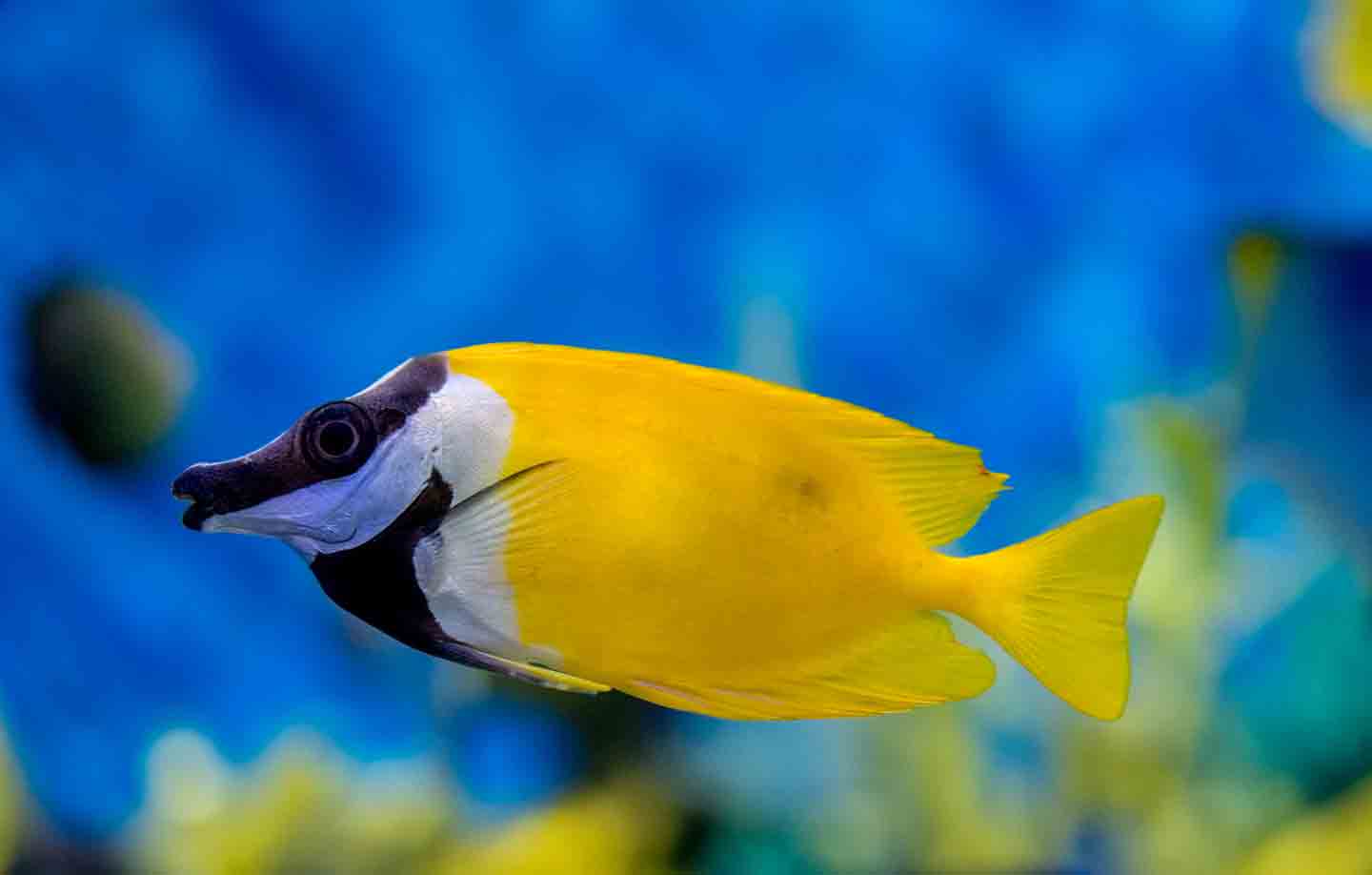
11Foxface Rabbitfish
- Scientific name: Siganus vulpinus
- Adult size: 7-9 inches
- Life expectancy: 5-7 years
- Best tank mates: Medium to large community fish
Named for their elongated snout, foxface rabbitfish are vibrant yellow with white and black markings on the face. They’re a ray-finned species with venomous dorsal spines. These rabbitfish feed primarily on algae. They’re very active swimmers, so they need a large tank with plenty of live rock to grow natural food sources for them to forage. They should not be housed with other rabbitfish, who can bring out an aggressive side in this otherwise peaceful fish.
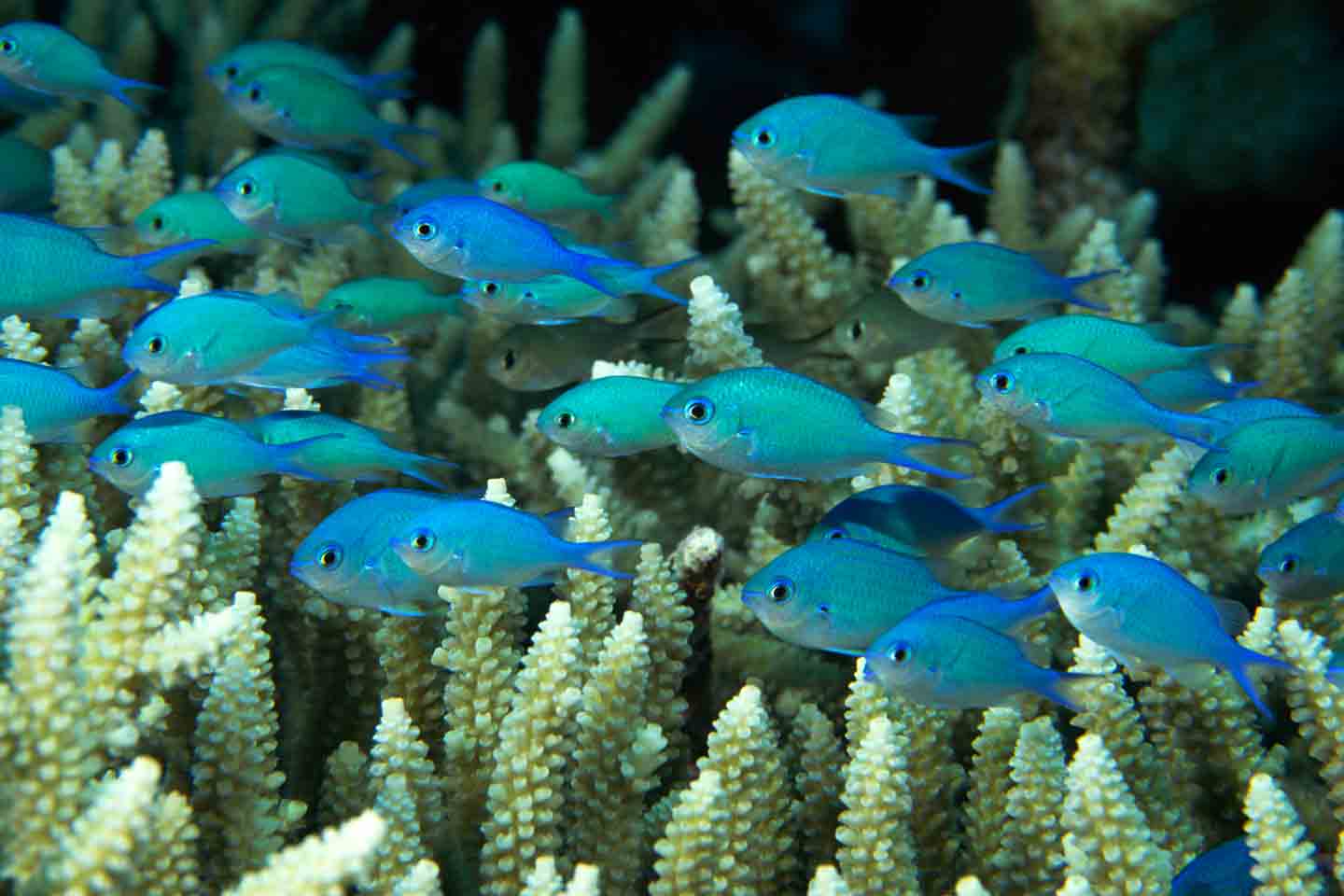
12Blue-Green Chromis
- Scientific name: Chromis viridis
- Adult size: 3-4 inches
- Life expectancy: 8-12 years
- Best tank mates: Peaceful community fish
Blue-green chromis are popular for novice saltwater aquarists because they stay small and they’re generally hardy enough to tolerate beginner mistakes. They’re members of the damselfish family, easily identified by their iridescent blue-green color. Chromis are best kept in small schools with other community fish. They are reef-safe.
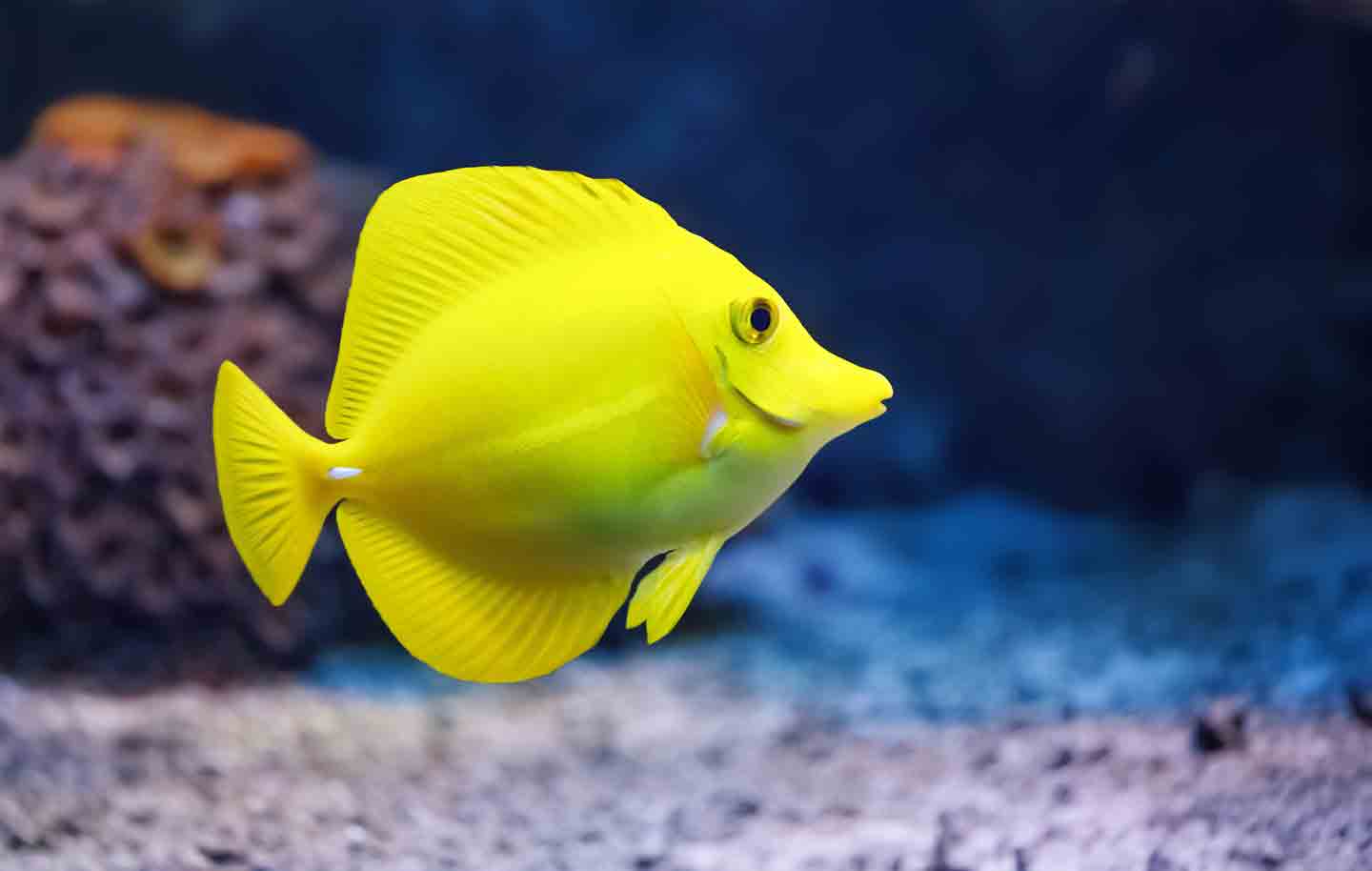
13Yellow Tang
- Scientific name: Zebrasoma flavescens
- Adult size: 8 inches
- Life expectancy: 10-40 years
- Best tank mates: Non-aggressive marine species
Easily one of the most popular saltwater fish among aquarium hobbyists, yellow tangs exhibit an all-over vibrant yellow color. They’re generally peaceful by nature but can become aggressive toward others of their kind. Yellow tangs are reef-safe because they feed primarily on algae, but some might nip at coral.

14 Blue Tang (Regal Blue Tang)
- Scientific name: Paracanthurus hepatus
- Adult size: 10-12 inches
- Life expectancy: 8-20 years
- Best tank mates: Non-aggressive marine species
Immediately familiar to fans of a certain Pixar film, the regal blue tang is bright blue with a yellow caudal fin and dark black running in a distinct pattern from the eye to the tail. This species is a member of the surgeonfish family and is one of the most active swimmers in the aquarium trade. They need a large tank with plenty of room and non-aggressive tank mates. It’s best if they’re the only tang in the tank; other tangs can inspire aggression.
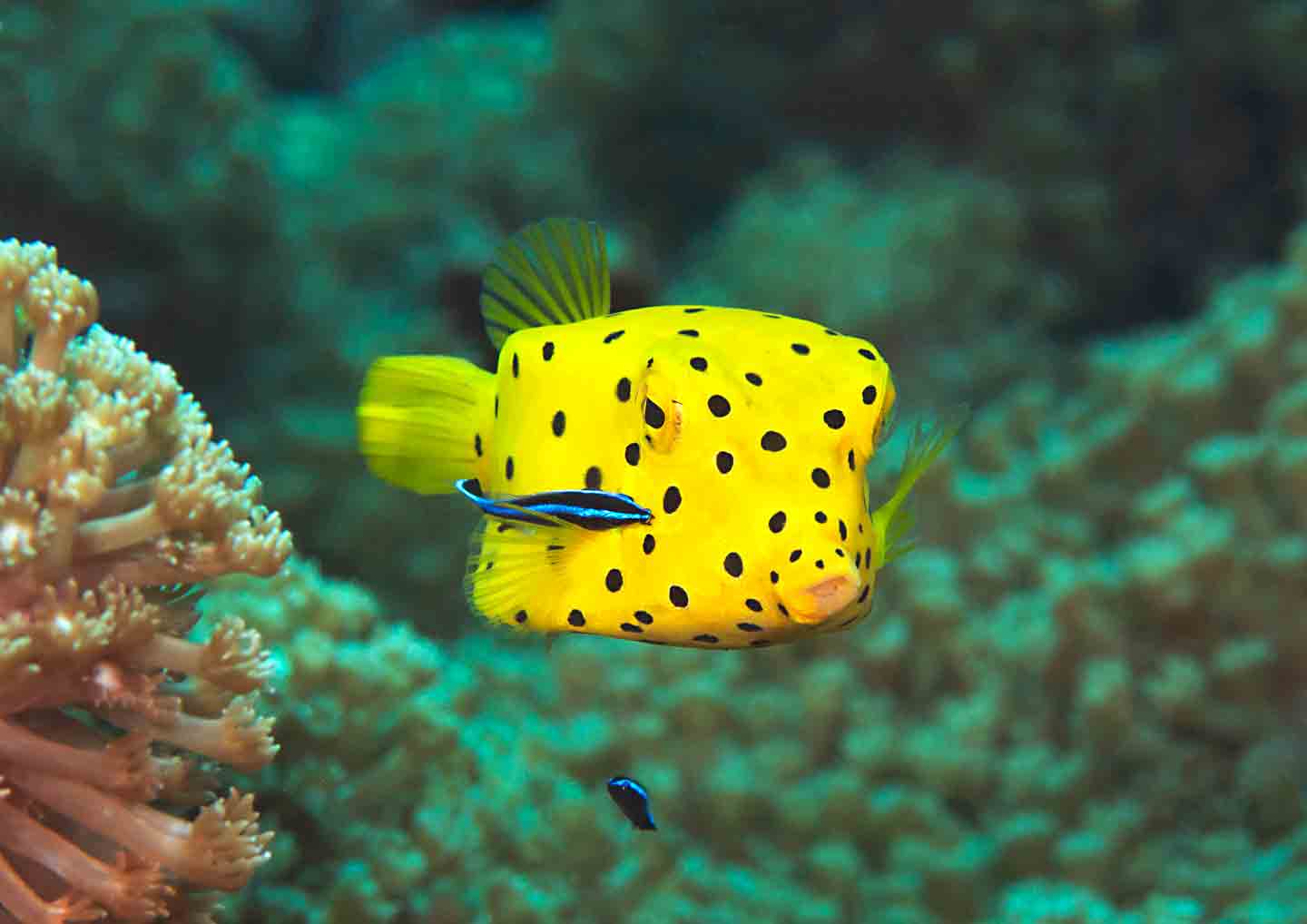
15Yellow Boxfish
- Scientific name: Ostracion cubicus
- Adult size: 8-20 inches
- Life expectancy: 5-10 years
- Best tank mates: Docile fish
Named for their squarish shape, boxfish are native to the Indian and Pacific Oceans. Juveniles of this species are bright yellow and covered in black spots. As the fish ages, the color fades to yellow-gray or even brown with a yellow tail. These fish are generally kept in large tanks with docile tank mates. When threatened, boxfish release a toxin that can be poisonous to other fish.
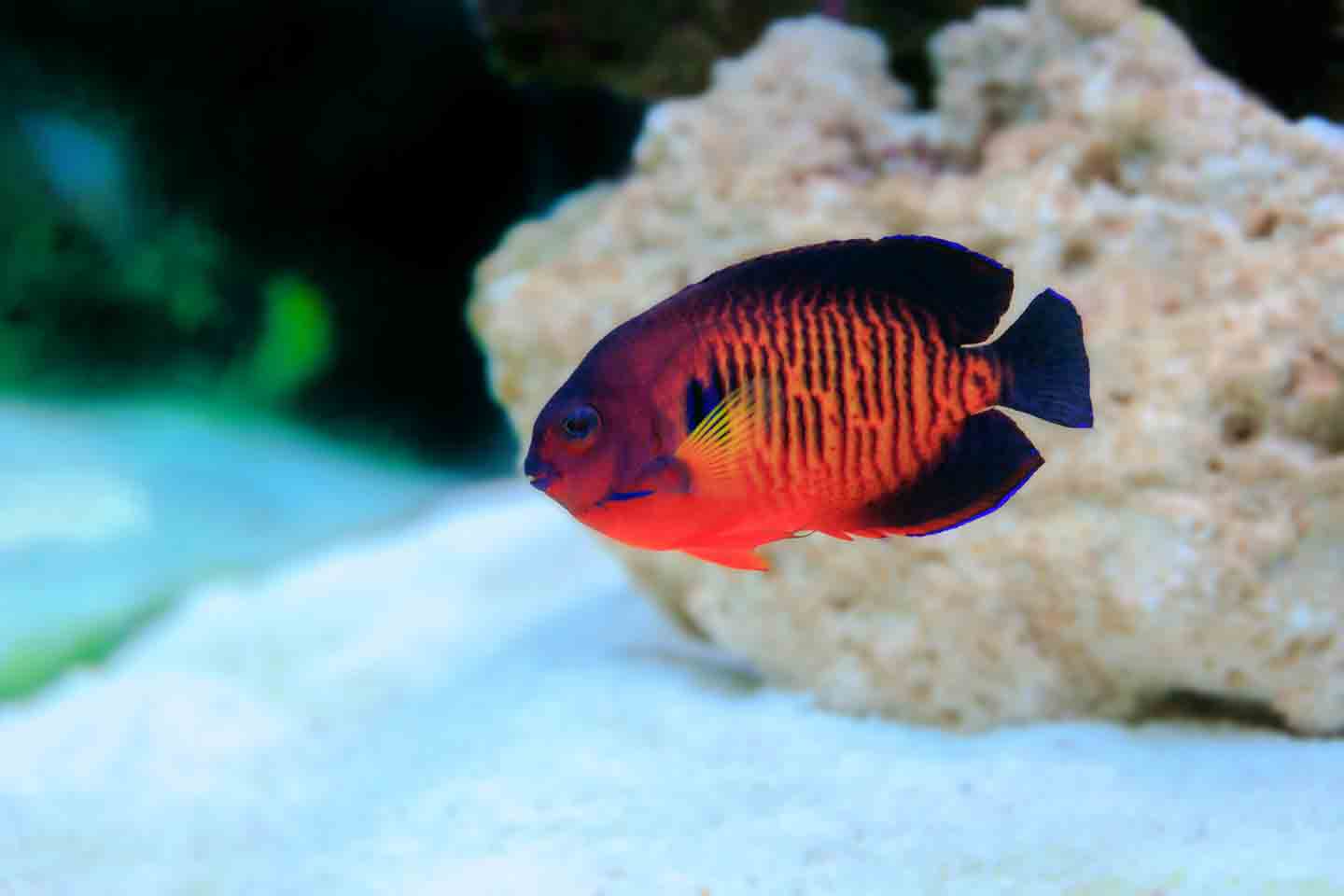
16Coral Beauty Angelfish
- Scientific name: Centropyge bispinosa
- Adult size: 2-4 inches
- Life expectancy: 7-10 years
- Best tank mates: Semi-aggressive marine fish
These marine angelfish in the genus Centropyge are sometimes referred to as dwarf angels. Coral beauty angelfish exhibit a dark purple-blue color marked with bright orange bars. They can be feisty at times, so it’s best to keep them with semi-aggressive tank mates who can hold their own.
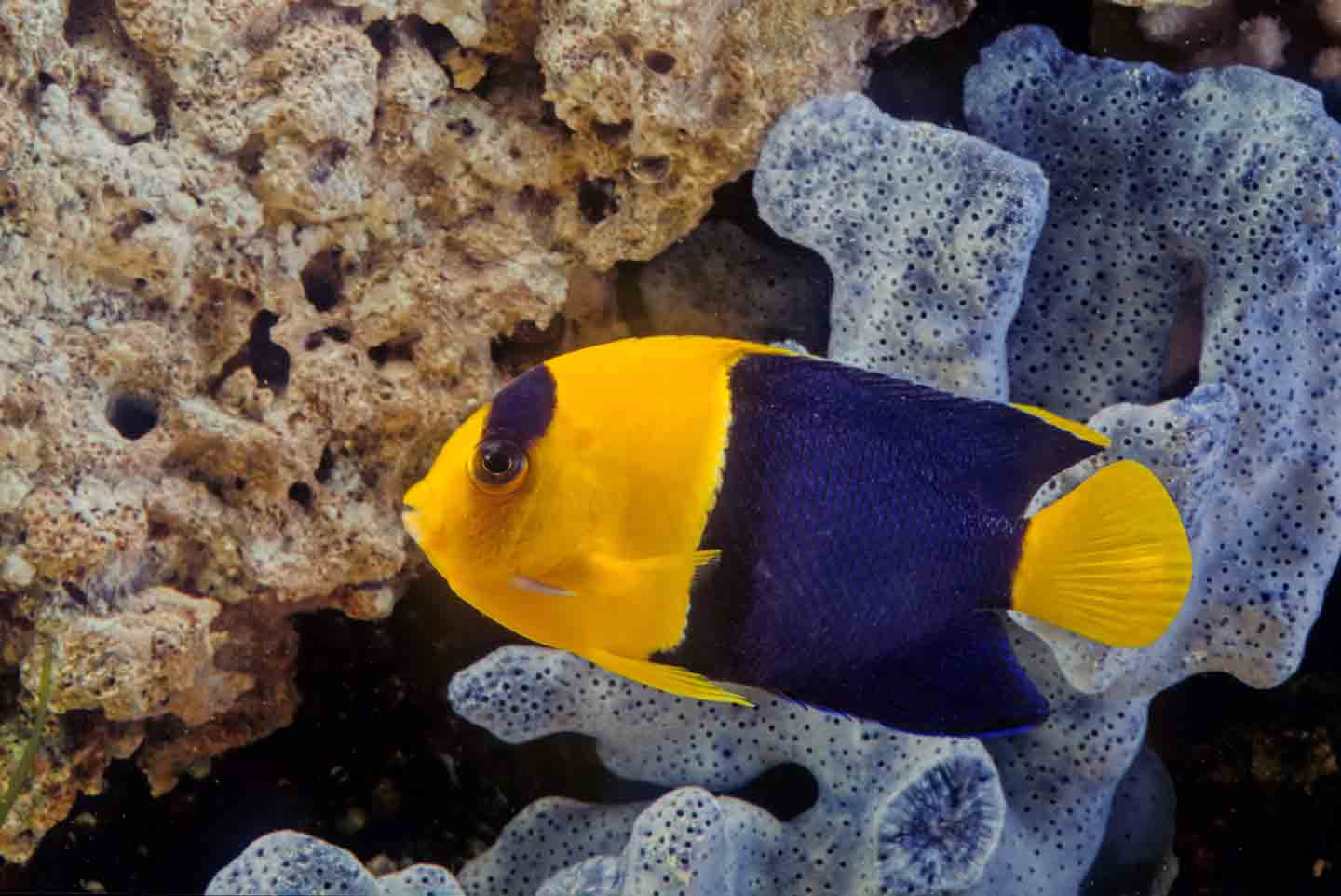
17Bicolor Angelfish
- Scientific name: Centropyge bicolor
- Adult size: 6 inches
- Life expectancy: 5-12 years
- Best tank mates: Semi-aggressive marine fish
Another dwarf angel, bicolor angelfish are easy to identify. They’re bright yellow in front and bright blue in back with a yellow tail and blue coloring around the eye. Due to their territorial instincts, it’s best to keep only a single bicolor angelfish per tank unless the tank is very large or the fish differ significantly in appearance. Otherwise, they may display aggression toward fish they think are of their own kind.
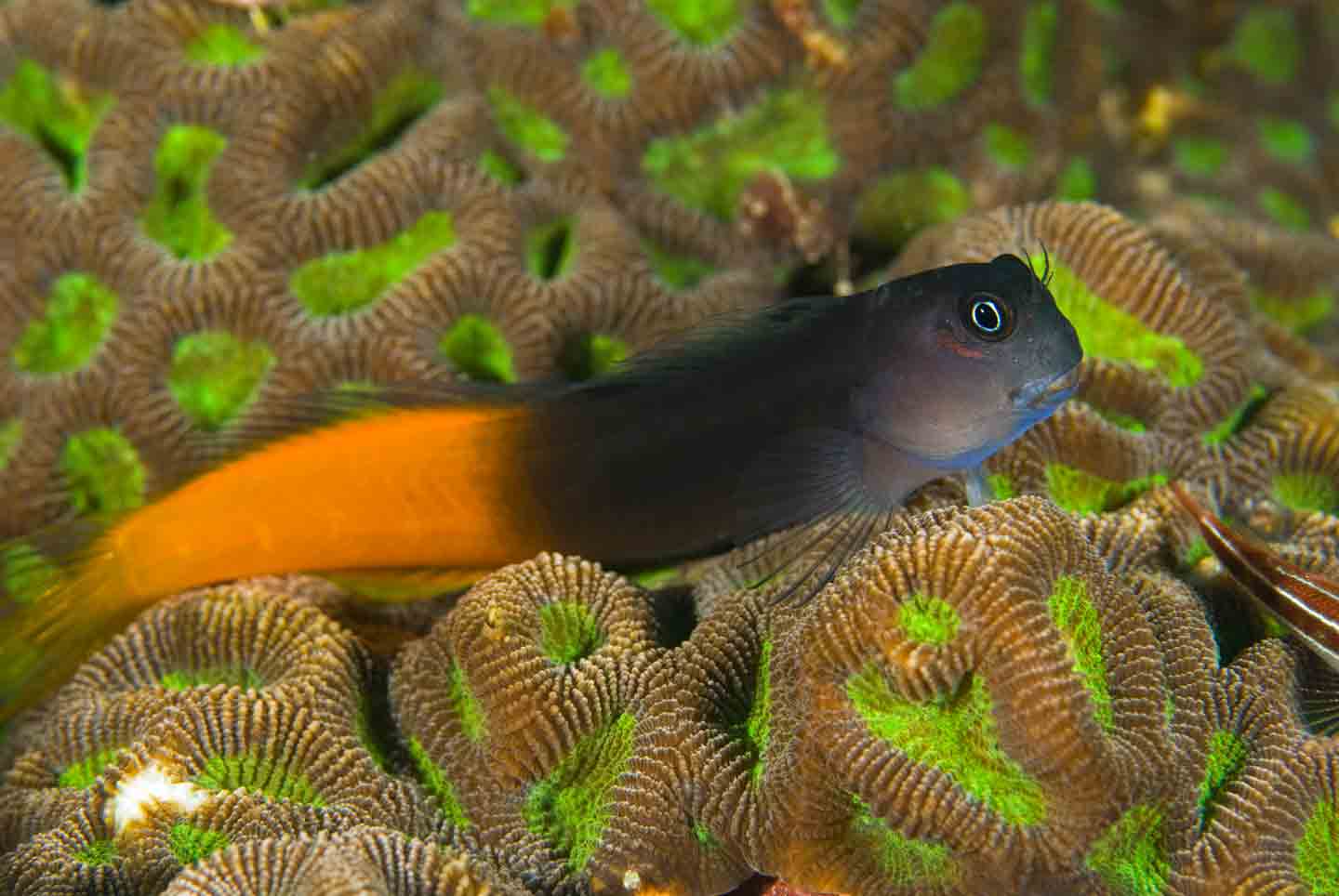
18Bicolor Blenny
- Scientific name: Ecsenius bicolor
- Adult size: 4 inches
- Life expectancy: 2-4 years
- Best tank mates: Non-aggressive species
Named for their two-tone coloration, bicolor blennies are dull blue to brown in front with dull orange color on the back half. Blennies are known for their entertaining personalities, and they make peaceful additions to the reef tank. They’ll be happy with most non-aggressive species as long as they have plenty of live rock to explore and hide in.
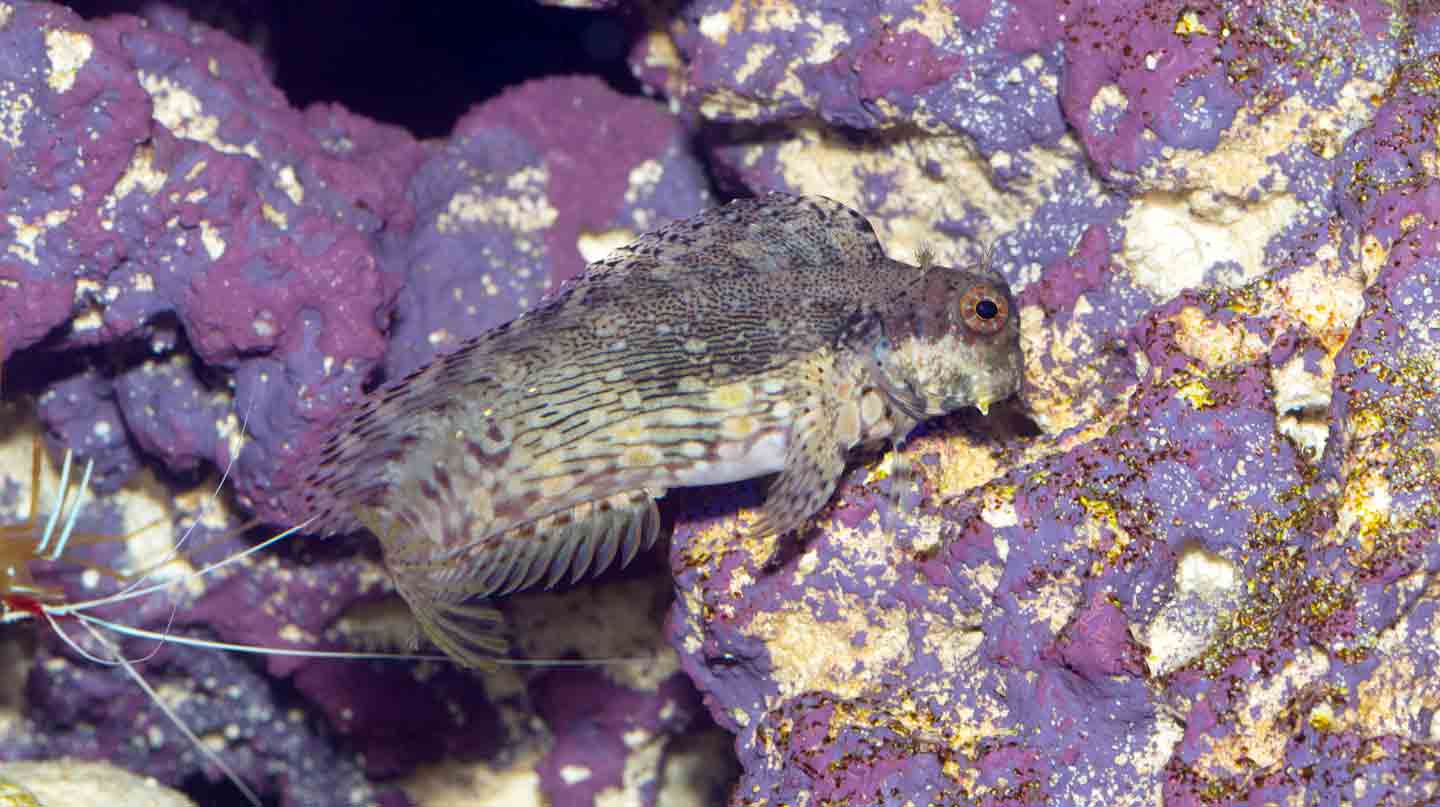
19Lawnmower Blenny
- Scientific name: Salarias fasciatus
- Adult size: 5 inches
- Life expectancy: 2-5 years
- Best tank mates: Non-aggressive species
Also known as the jeweled rockskipper, the lawnmower blenny exhibits a mottled pattern in neutral tones with oversized eyes and a sail fin. This species gets a little bigger than other blennies, but it’s still a peaceful, reef-safe fish. Like other blennies, they’re only likely to start trouble with tank mates who are similar in shape or appearance.
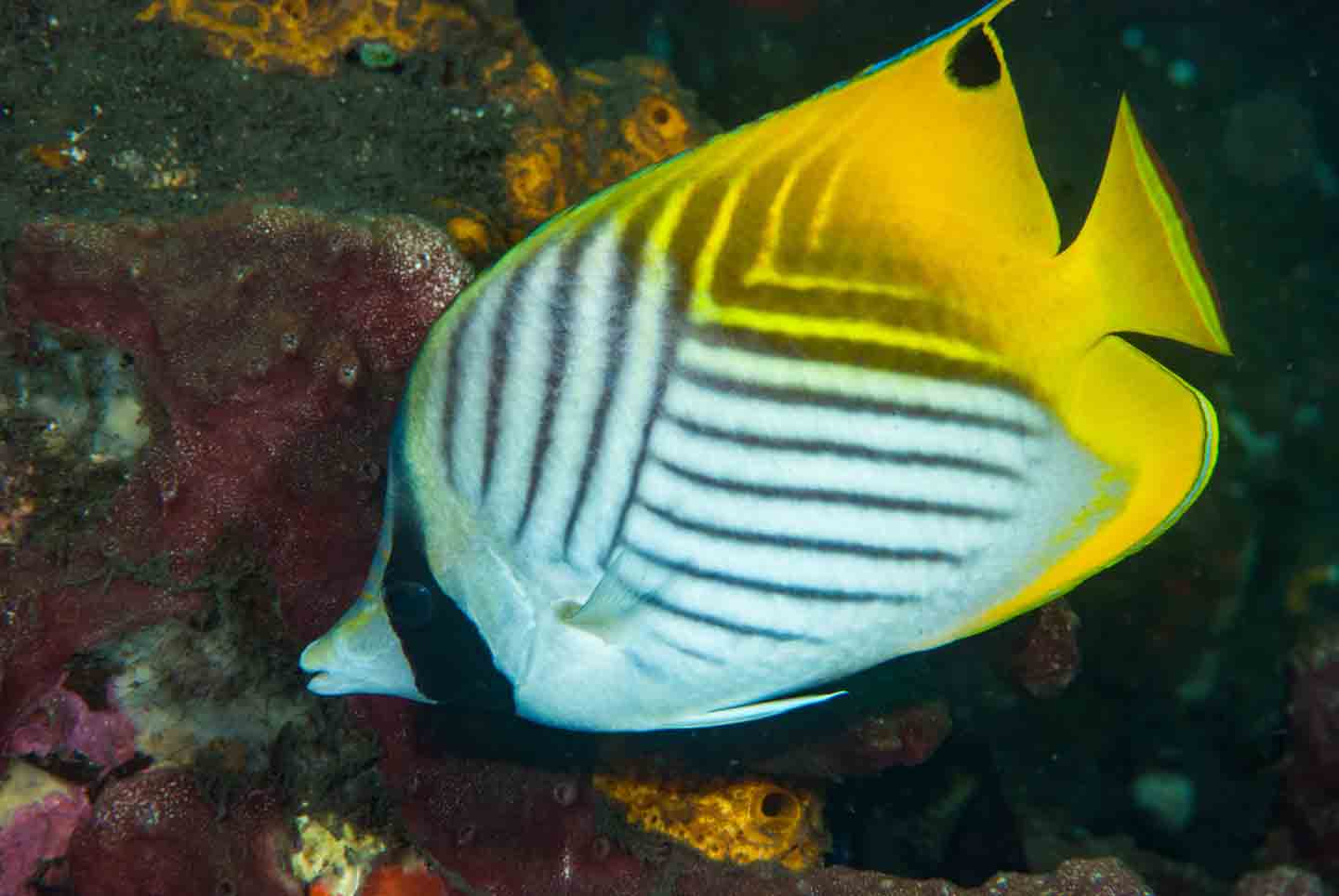
20Threadfin Butterflyfish
- Scientific name: Chaetodon auriga
- Adult size: 6-9 inches
- Life expectancy: 5 years
- Best tank mates: Small, non-aggressive species
The threadfin or auriga butterflyfish is stark white with dark chevron markings along the side. White transitions into vibrant yellow on the back half of the fish with a black spot (called a false eye) on the dorsal fin and a vertical black band running through the eye. These fish are not reef safe (they tend to nibble on or eat corals and other invertebrates found in reef tanks) and do best with small, non-aggressive species.
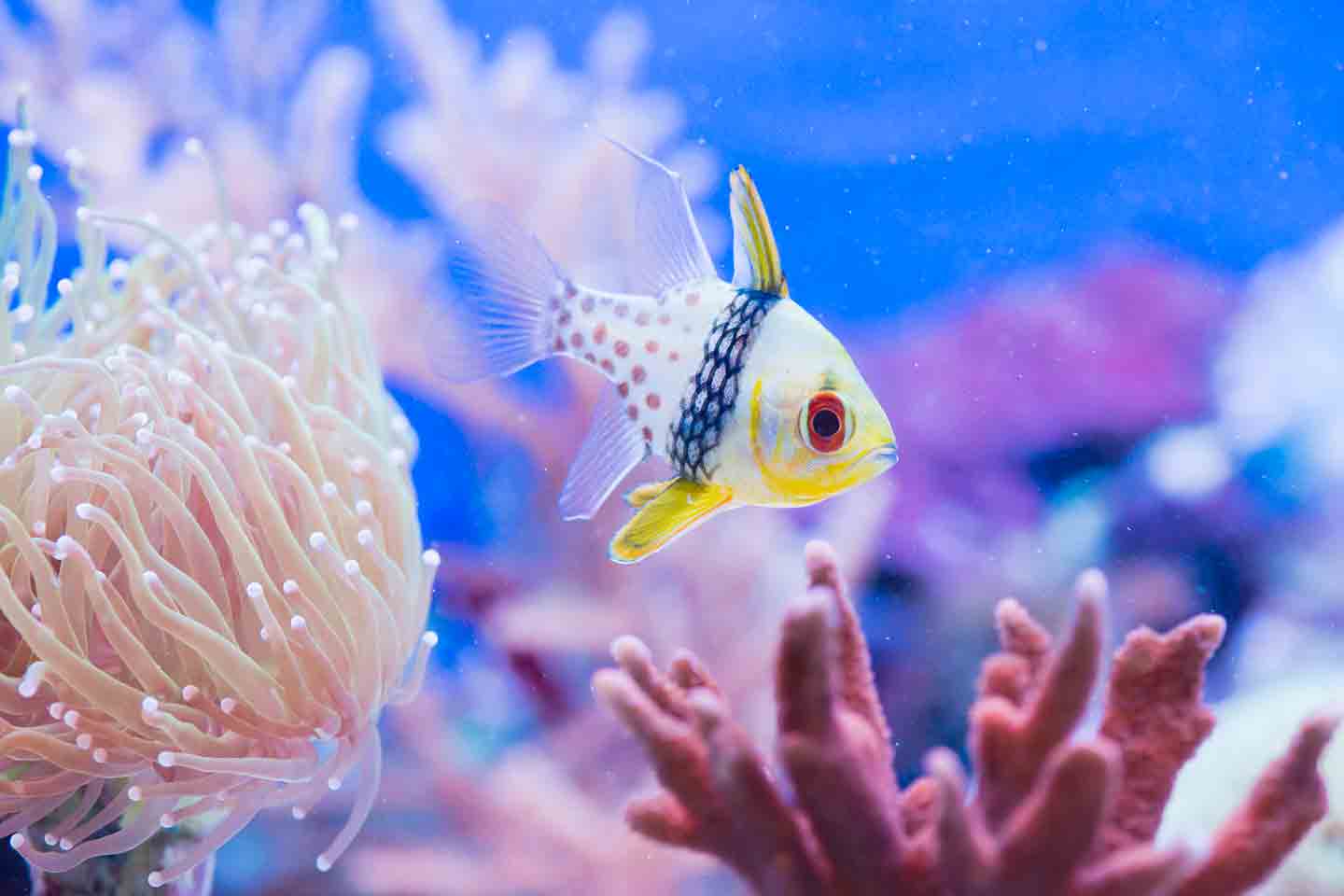
21Pajama Cardinalfish
- Scientific name: Sphaeramia nematoptera
- Adult size: 3.5 inches
- Life expectancy: up to 15 years
- Best tank mates: Peaceful community fish
A great fit for smaller tanks, pajama cardinalfish make a colorful and active addition to the community saltwater aquarium. They have a silver body with a green-yellow color on the front and orange spots on the back. The body is divided by a vertical black band, and the eyes are bright orange. Pajama cardinalfish are a social, schooling species best kept with peaceful tank mates.
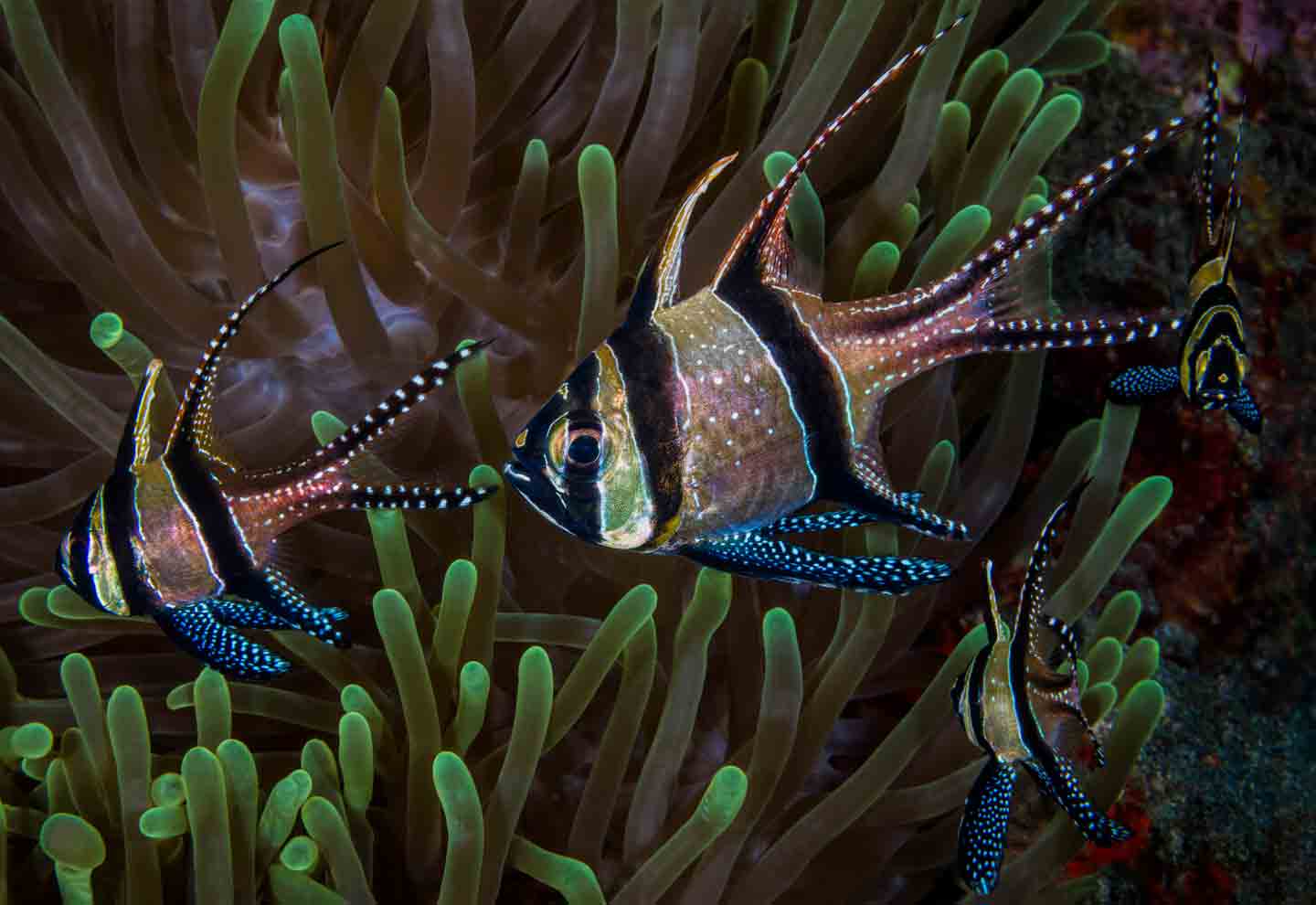
22Banggai Cardinalfish
- Scientific name: Pterapogon kauderni
- Adult size: 3.4 inches
- Life expectancy: 2.5-5 years
- Best tank mates: Peaceful community fish
Banggai cardinalfish are easily distinguished from other cardinalfish by their elongated fins and black barred pattern. Unlike most of their relatives, Banggai cardinalfish are diurnal (active during the day), but they’ll still appreciate having places to hide.

23Longnose Hawkfish
- Scientific name: Oxycirrhites typus
- Adult size: 5 inches
- Life expectancy: 5-7 years
- Best tank mates: Peaceful, non-territorial fish
Longnose hawkfish stand out with their long, pointed nose and red checkerboard patterning. These fish need plenty of rockwork to hide in and, because they can be territorial, it’s best to add them to your tank last. Hawkfish are predatory, so they’ll help control unwanted invertebrates, but they may also eat other fish if they’re small enough.
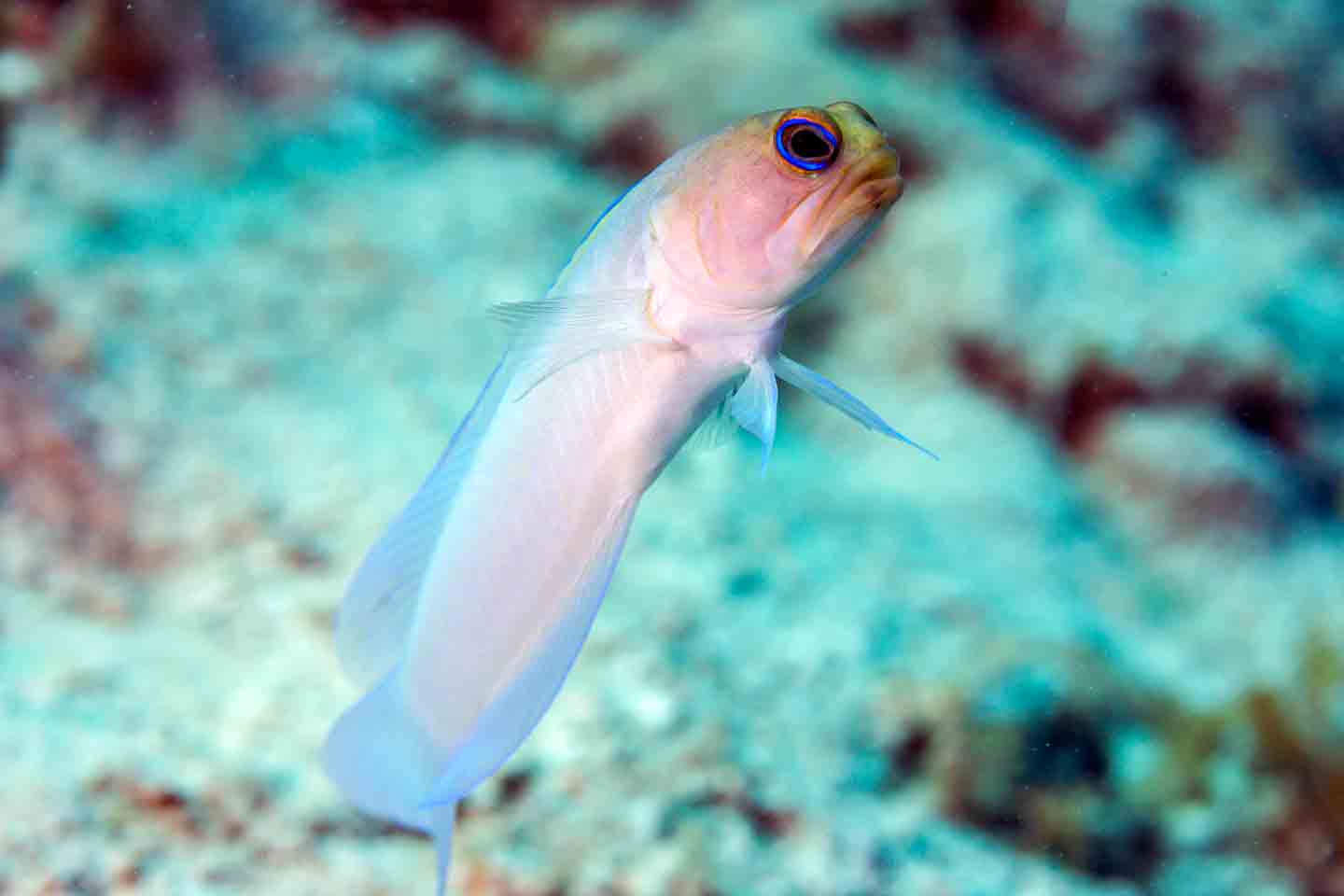
24Yellowhead Jawfish
- Scientific name: Opistognathus aurifrons
- Adult size: 4 inches
- Life expectancy: 5-8 years
- Best tank mates: Peaceful marine fish
Named for their vibrant yellow color and large mouth, yellowhead jawfish burrow into the substrate like gobies. They’ve been known to move rocks and sand by mouth when digging their burrows. The yellowhead jawfish’s yellow body color fades to a pearlescent blue on the bottom. This species can be territorial but generally does well with peaceful marine fish.
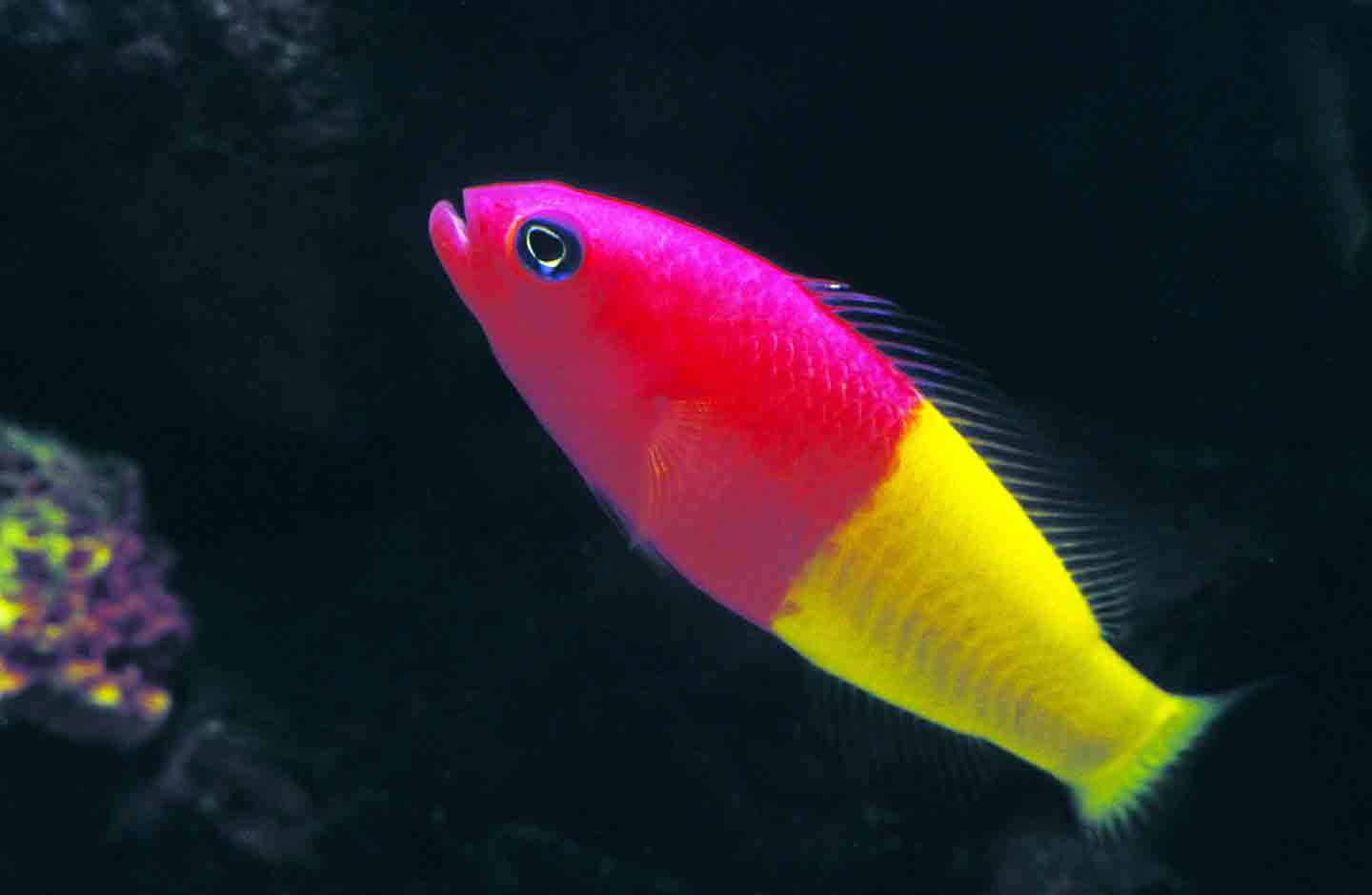
25Dottyback
- Scientific name: Pseudochromis spp.
- Adult size: 2-4 inches
- Life expectancy: 5-7 years
- Best tank mates: Large or fast-moving reef fish
Dottybacks are a family of Perciformes fishes found in coral reefs throughout the Indo-Pacific. They’re known for their bright colors and sexual dimorphism (physical differences between males and females). Although they’re small, dottybacks can be very territorial and may bully non-aggressive tank mates. Depending on the species, they require a carnivorous or omnivorous diet and a tank decorated with plenty of rockwork and corals.

26Moorish Idol
- Scientific name: Zanclus cornutus
- Adult size: 8-9 inches
- Life expectancy: 2-4 years
- Best tank mates: Non-aggressive marine species
The moorish idol is a ray-finned fish easily identified by its disc-like shape, tubish snout and the whiplike extension of the dorsal fin. These fish are mostly white with two wide black vertical bands and yellow coloring on the posterior end. Because they require a very large tank and have a very particular appetite, moorish idols are best suited to experienced hobbyists looking for a challenge.
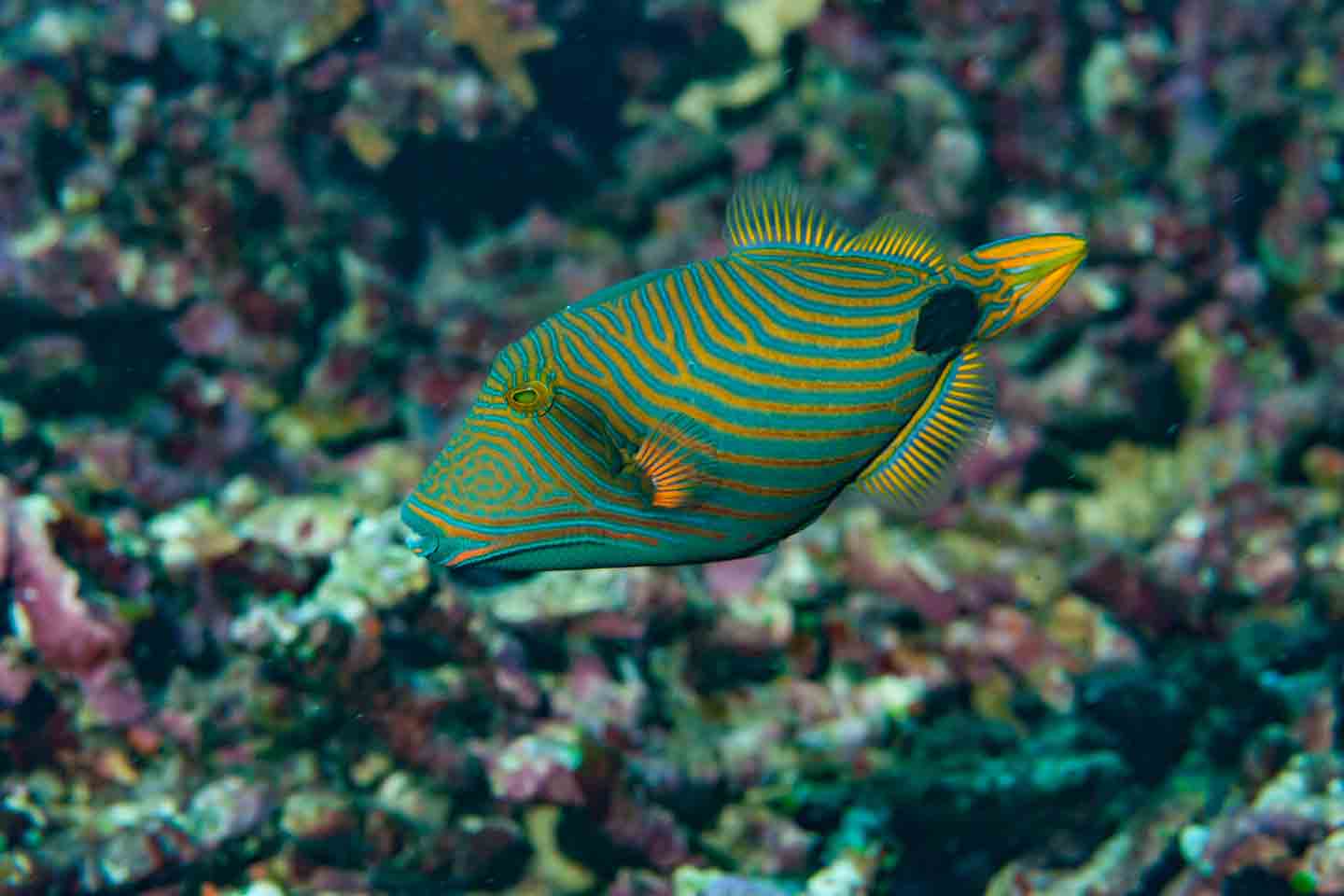
27Undulate Triggerfish
- Scientific name: Balistapus undulatus
- Adult size: 10-12 inches
- Life expectancy: 5-10 years
- Best tank mates: Large, aggressive and semi-aggressive species
Also known as the orange-striped, orangetailed or orangelined triggerfish, undulate triggerfish have an emerald-green body covered with yellow-orange stripes. Triggerfish are another challenging but hardy marine species best suited to experienced hobbyists with a large tank. These fish are highly aggressive and omnivorous, requiring a varied diet of meaty foods like clams, squid and small fish.
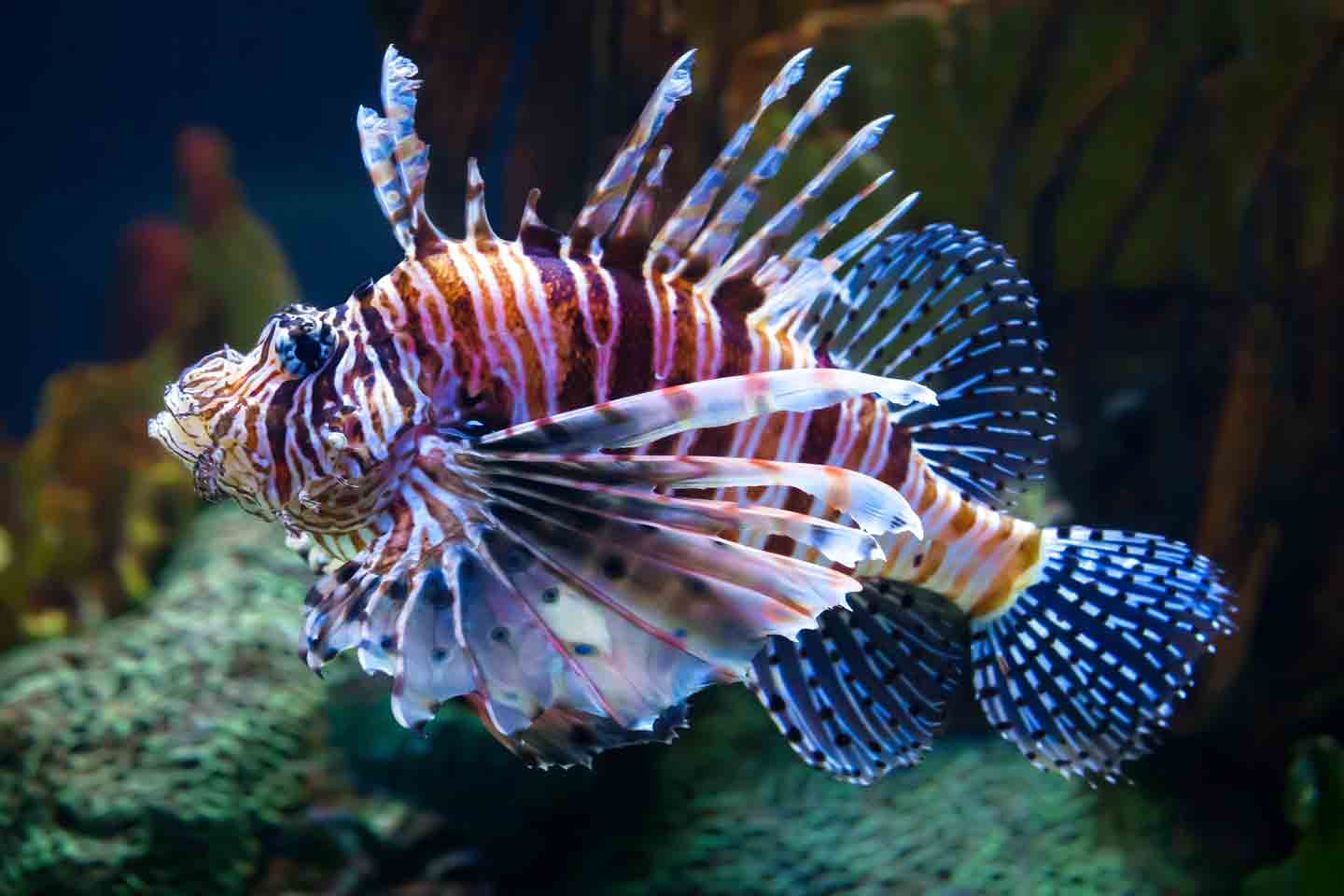
28Red Lionfish
- Scientific name: Pterois volitans
- Adult size: 12-18 inches
- Life expectancy: 15 years
- Best tank mates: Versatile
Lionfish are large, coral-reef fish known for their striped pattern and venomous spikes. Aside from their striking appearance, lionfish are valued by experienced hobbyists for their compatibility with both aggressive and non-aggressive species. The best tank mates for lionfish are any fish large enough that they can’t become prey.
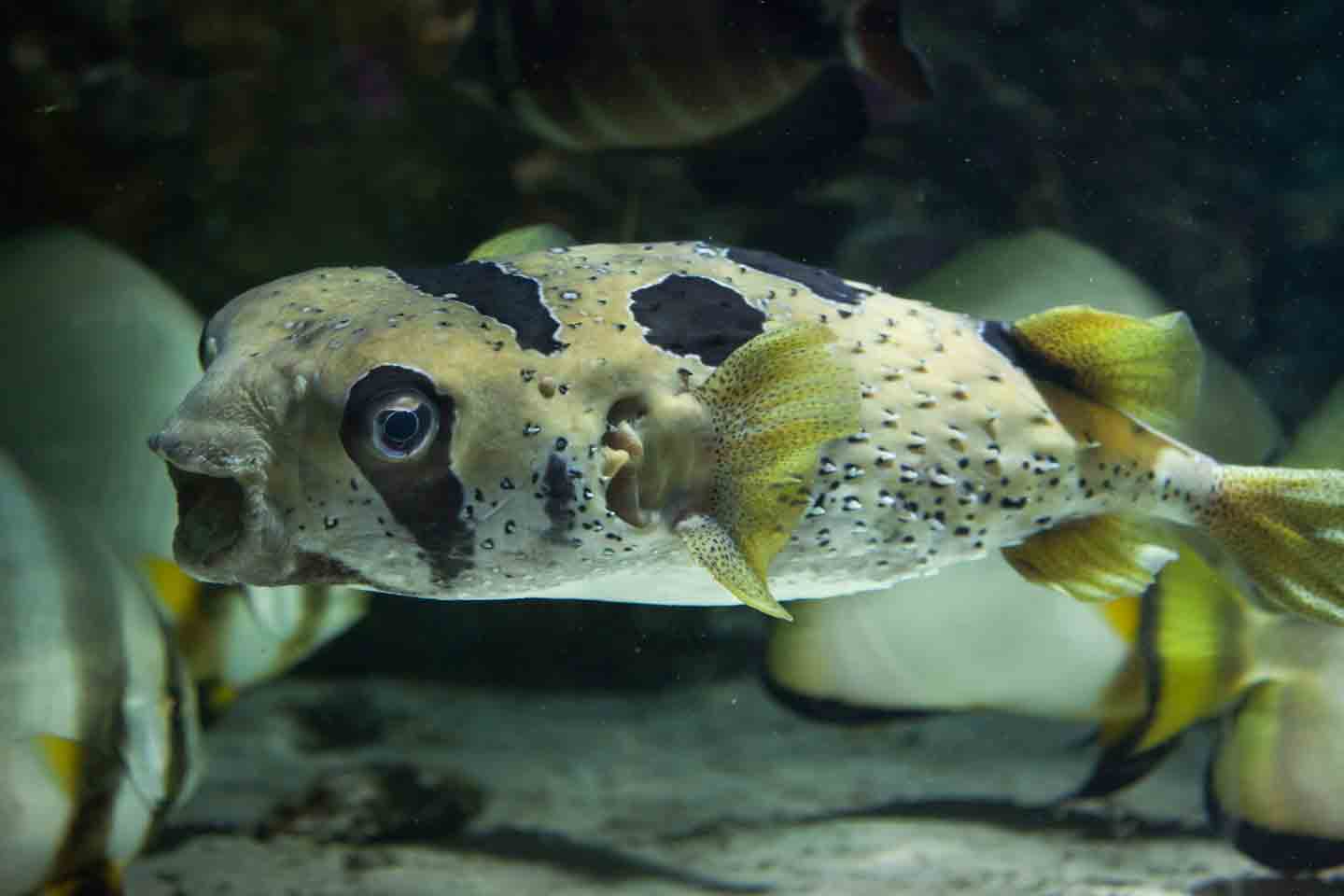
29Balloonfish (Porcupine Puffer)
- Scientific name: Diodon holocanthus
- Adult size: 8-20 inches
- Life expectancy: 10 years
- Best tank mates: Medium to large marine fish
Balloonfish, aka porcupine pufferfish or spiny puffers, are some of the most intelligent species in marine aquaculture. They have outgoing personalities and often engage with their caregivers by begging for food. Though they require a very large aquarium, they’re quite hardy and can live for 10 years. Keep in mind that these fish tend to be messy eaters, so frequent water changes may be necessary.
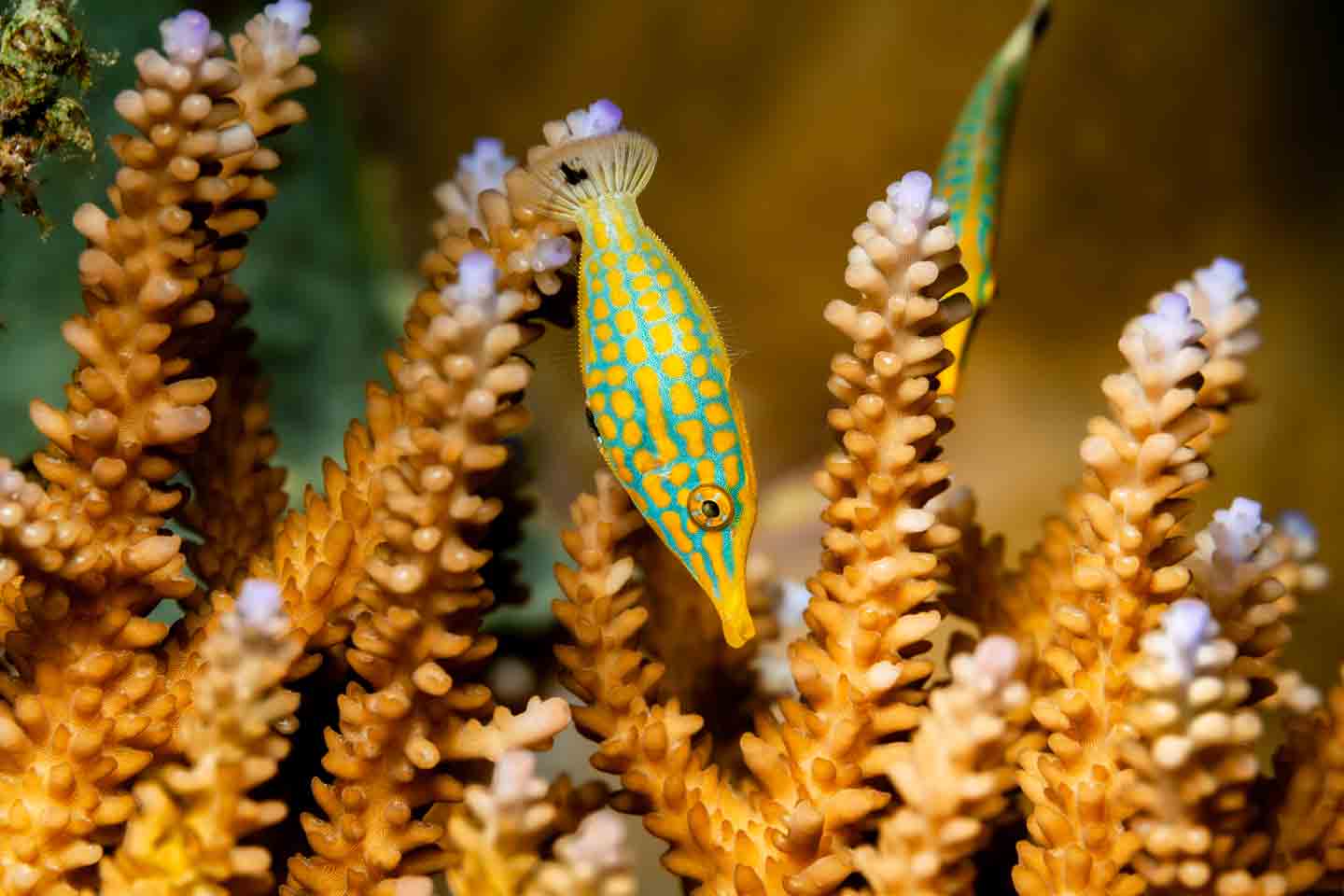
30Harlequin Filefish
- Scientific name: Oxymonacanthus longirostris
- Adult size: 5-7 inches
- Life expectancy: 3-5 years
- Best tank mates: Peaceful community fish
On the opposite end of the spectrum, the harlequin filefish is a peaceful reef-safe species compatible with other community fish. What makes this species challenging is its diet. Filefish feed primarily on polyps of Acropora corals in the wild and may refuse other foods. Harlequin filefish are blue-green in color and covered in yellow to orange spots and dashes.
FAQs About Saltwater Fish
Q:What is the most popular saltwater fish?
A:Because they’re relatively simple to care for and easy to find, ocellaris clownfish are one of the most popular species of saltwater fish for hobby aquarists. Dr. Jessie Sanders, DVM, DABVP, owner of Aquatic Veterinary Services in Santa Cruz, California, recommends that hobbyists select “cultured rather than wild-caught individuals.” Captive-bred specimens are generally hardier and more accepting of commercial foods than wild specimens.
Q:What is the most aggressive saltwater fish?
A:Very large and predatory saltwater fish tend to be the most aggressive species. Examples include grouper, lionfish and eels. Smaller species like damselfish and wrasse can also be aggressive in defending their territory. If you plan to include aggressive species in your saltwater tank, Amanda Fredal, LVT, a veterinary technician in Richmond County, Georgia, and member of the Aquatic Committee for the Pet Advocacy Network, based in Alexandria, Virginia, recommends adding them last. “Start with the least aggressive fish you plan to keep,” she says, “and slowly introduce fish one or two at a time.”
Q:How do you acclimate saltwater fish to a new aquarium?
A:Empty the bag your fish came in into a bucket and slowly feed water from the tank into the bucket using a length of aquarium airline tubing. Start a siphon and tie knots in the tubing to slow the flow as needed. Once the fish is acclimated, carefully net it and transfer it to a perforated acrylic box installed inside the tank. The fish should remain here until initial signs of aggression from other fish die down. If there are no other fish in the tank yet, you can release the fish directly into the tank.
Before introducing any fish at all, Dr. Serena Brenner, MS, DVM, CertAqV, course facilitator at UC Davis School of Veterinary Medicine in Davis, California, stresses the importance of making sure your tank is fully cycled. “You want all live organisms and inverts in place,” she says, “prior to adding your stock of fish.”
Looking for more potential species? Check out these five sharks for your saltwater aquarium.
Expert input was provided by Dr. Jessie Sanders, DVM, DABVP, owner of Aquatic Veterinary Services in Santa Cruz, California; Amanda Fredal, LVT, a veterinary technician in Richmond County, Georgia, and member of the Aquatic Committee for the Pet Advocacy Network; and Dr. Serena Brenner, MS, DVM, CertAqV, course facilitator at UC Davis School of Veterinary Medicine in Davis, California.
Keep Your Fish Healthy
Share:



